Florida State University
Florida State University (Florida State or FSU) is a public space-grant and sea-grant research university in Tallahassee, Florida. It is a senior member of the State University System of Florida. Founded in 1851, it is located on the oldest continuous site of higher education in the state of Florida.[2][4]
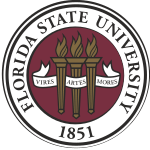 | |
| Motto | Vires, Artes, Mores |
|---|---|
Motto in English | Strength, Skill, Character (Latin) |
| Type | State university Sea-grant university Space-grant university |
| Established | 1851[note 1] |
Academic affiliations | |
| Endowment | $704.1 million (2019)[5] |
| Budget | $1.7 billion (2017) |
| Chairman | Ed Burr |
| President | John E. Thrasher |
| Provost | Sally McRorie |
Academic staff | 5,966[6] |
Administrative staff | 8,133[7] |
| Students | 41,551 (Fall 2019)[8] |
| Undergraduates | 32,164 (Fall 2019)[8] |
| Postgraduates | 9,387 (Fall 2019)[8] |
| Location | , , United States 30.442°N 84.298°W |
| Campus | 1,428.6 acres (5.781 km2) Total: 1,650.1 acres (6.678 km2)[9] |
| Colors | Garnet and Gold[10] |
| Nickname | Seminoles |
Sporting affiliations | NCAA Division I – ACC |
| Website | www |
The university is classified among "R1: Doctoral Universities – Very high research activity".[11] The university comprises 16 separate colleges and more than 110 centers, facilities, labs and institutes that offer more than 360 programs of study, including professional school programs.[12] The university has an annual budget of over $1.7 billion and an annual economic impact of over $10 billion.[13][14] Florida State is home to Florida's only national laboratory, the National High Magnetic Field Laboratory, and is the birthplace of the commercially viable anti-cancer drug Taxol. Florida State University also operates the John & Mable Ringling Museum of Art, the State Art Museum of Florida and one of the largest museum/university complexes in the nation.[15] The university is accredited by the Southern Association of Colleges and Schools (SACS).
For 2020, U.S. News & World Report ranked Florida State as the 18th best public university in the United States in the national university category.[16]
FSU's intercollegiate sports teams, commonly known by their "Florida State Seminoles" nickname, compete in National Collegiate Athletic Association (NCAA) Division I and the Atlantic Coast Conference (ACC). In their 113-year history, Florida State's varsity sports teams have won 20 national athletic championships and Seminole athletes have won 78 individual NCAA national championships.[17]
History
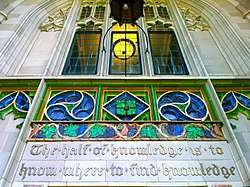
In 1819 the Florida Territory was ceded to the United States by Spain as an element of the Adams–Onís Treaty.[18] The Territory was conventionally split by the Appalachicola or later the Suwannee rivers into East and West areas. Florida State University is traceable to a plan set by the 1823 U.S. Congress to create a system of higher education.[19] The 1838 Florida Constitution codified the basic system by providing for land allocated for the schools.[20] In 1845 Florida became the 27th State of the United States, which permitted the resources and intent of the 1823 Congress regarding education in Florida to be implemented.
The Legislature of the State of Florida, in a Legislative Act of January 24, 1851, provided for the establishment of the two institutions of learning on opposite sides of the Suwannee River. The Legislature declared the purpose of these institutions to be "the instruction of persons, both male and female, in the art of teaching all the various branches that pertain to a good common school education; and next to give instruction in the mechanic arts, in husbandry, in agricultural chemistry, in the fundamental laws, and in what regards the rights and duties of citizens." [21] By 1854 the City of Tallahassee had established a school for boys called the Florida Institute, with the hope that the State could be induced to take it over as one of the seminaries. In 1856, Tallahassee Mayor Francis W. Eppes again offered the Institute's land and building to the Legislature. The bill to locate the Seminary in Tallahassee passed both houses and was signed by the Governor on January 1, 1857. On February 7, 1857, the first meeting of the Board of Education of the State Seminary West of the Suwannee River was held, and the institution began offering post-secondary instruction to male students. Francis Eppes served as President of the Seminary's Board of Education for eight years.[21] In 1858 the seminary absorbed the Tallahassee Female Academy, established in 1843, and became coeducational.[22]
The West Florida Seminary was located on the former Florida Institute property, a hill where the historic Westcott Building now stands. The location is the oldest continuously used site of higher education in Florida. The area, slightly west of the state Capitol, was formerly and ominously known as Gallows Hill, a place for public executions in early Tallahassee.[23]
Civil War and Reconstruction
In 1860–61 the legislature started formal military training at the school with a law amending the original 1851 statute.[24] During the Civil War, the seminary became The Florida Military and Collegiate Institute. Enrollment at the school increased to around 250 students with the school establishing itself as perhaps the largest and most respected educational institution in the state.[24] Cadets from the school defeated Union forces at the Battle of Natural Bridge in 1865, leaving Tallahassee as the only Confederate capital east of the Mississippi River not to fall to Union forces.[25][26] The students were trained by Valentine Mason Johnson, a graduate of Virginia Military Institute, who was a professor of mathematics and the chief administrator of the college.[27] After the fall of the Confederacy, campus buildings were occupied by Union military forces for approximately four months and the West Florida Seminary reverted to its former academic purpose.[28] In recognition of the cadets, and their pivotal role in the battle, the Florida State University Army ROTC cadet corps displays a battle streamer bearing the words "NATURAL BRIDGE 1865" with its flag. The FSU Army ROTC is one of only four collegiate military units in the United States with permission to display such a pennant.[29]
First state university
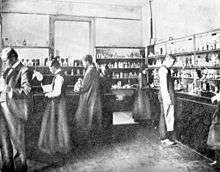
In 1883 the institution, now long officially known as the West Florida Seminary, was organized by the Board of Education as The Literary College of the University of Florida. Under the new university charter, the seminary became the institution's Literary College, and was to contain several "schools" or departments in different disciplines.[30] However, in the new university association the seminary's "separate Charter and special organization" were maintained.[31] Florida University also incorporated the Tallahassee College of Medicine and Surgery, and recognized three more colleges to be established at a later date.[30] The Florida Legislature recognized the university under the title "University of Florida" in Spring 1885, but committed no additional financing or support.[21][32] Without legislative support, the university project struggled. The institution never assumed the "university" title,[32] and the association dissolved when the medical college relocated to Jacksonville later that year.[30]
However, the West Florida Seminary, as it was still generally called, continued to expand and thrive. It shifted its focus towards modern-style post-secondary education, awarding "Licentiates of Instruction", its first diplomas, in 1884,[21] and became Florida's first liberal arts college in 1897.[21] and by 1891 the Institute had begun to focus on modern post-secondary education; seven Bachelor of Arts degrees were awarded that year.[21]
In 1901 it became Florida State College, a four-year institution organized in four departments: the College, the School for Teachers, the School of Music, and the College Academy. Florida State College was empowered to award the degree of Master of Arts, and the first master's degree was offered in 1902. That year the student body numbered 252 men and women, and degrees were available in classical, literary and scientific studies. In 1903 the first university library was begun.[21]
Buckman Act
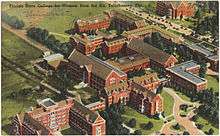
The 1905 Florida Legislature passed the Buckman Act, which reorganized the Florida college system into a school for white males (University of the State of Florida), a school for white females (Florida Female College later changed to Florida State College for Women), and a school for African Americans (State Normal and Industrial College for Colored Students).[33] The Buckman Act was controversial, as it changed the character of a historic coeducational state school into a school for women. An early and major benefactor of the school, James Westcott III (1839–1887), willed substantial monies to the school to support continued operations. In 1911 his estate sued the state educational board contending the estate was not intended to support a single-sex school. The Florida Supreme Court decided the issue in favor of the State of Florida stating the change in character (existing from 1905 to 1947) was within the intent of the Westcott will.[34] By 1933 the Florida State College for Women had grown to be the third largest women's college in the United States and was the first state women's college in the South to be awarded a chapter of Phi Beta Kappa, as well as the first university in Florida so honored.[35][36] Florida State was the largest of the original two state universities in Florida until 1919.[37]
"Florida State University"
Returning soldiers using the G.I. Bill after World War II stressed the state university system to the point that a Tallahassee Branch of the University of Florida (TBUF) was opened on the campus of the Florida State College for Women with the men housed in barracks on nearby Dale Mabry Field.[21] By 1947 the Florida Legislature returned the FSCW to coeducational status and designated it Florida State University.[38] The FSU West Campus land and barracks plus other areas continually used as an airport later became the location of the Tallahassee Community College. The post-war years brought substantial growth and development to the university as many departments and colleges were added including Business, Journalism (discontinued in 1959), Library Science, Nursing and Social Welfare.[39] Strozier Library, Tully Gymnasium and the original parts of the Business building were also built at this time.
Student activism and racial integration

During the 1960s and 1970s Florida State University became a center for student activism especially in the areas of racial integration, women's rights and opposition to the Vietnam War. The school acquired the nickname "Berkeley of the South"[40] during this period, in reference to similar student activities at the University of California, Berkeley. The school is also purported to have originated the 1970s fad of "streaking", said to have been first observed on Landis Green.[41][42]
After many years as a segregated university, in 1962 Maxwell Courtney became the first African-American undergraduate student admitted to Florida State.[43] In 1968 Calvin Patterson became the first African American player for the Florida State University football team.[44] Florida State today has the highest graduation rate for African American students of all universities in Florida.[45]
On March 4, 1969 the FSU chapter of Students for a Democratic Society, an unregistered university student organization, sought to use university facilities for meetings. The FSU administration, under President Stanley Marshall, subsequently decided not to allow the SDS the use of university property and obtained a court injunction to bar the group. The result was a protest and mass arrest at bayonet point of some 58 students in an incident later called the Night of the Bayonets.[46] The university Faculty Senate later criticized the administration's response as provoking as an artificial crisis.[47] Another notable event occurred when FSU students massed in protest of student deaths at Kent State University causing classes to be canceled.[48] Approximately 1000 students marched to the ROTC building where they were confronted by police armed with shotguns and carbines. Joining the all-night vigil, Governor Claude Kirk appeared unexpectedly with a wicker chair and spent hours, with little escort or fanfare, on Landis Green discussing politics with protesting students.[48]
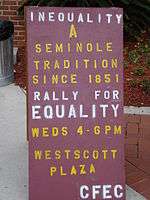
LGBTQ activism at FSU is unusual in that it was actually a fight against the school itself. The Pride Student Union (PSU), originally LGBSU, was founded in 1969 to represent LGBTQ students.[49][50] In 1980 a gay male named William Wade won the title of Homecoming Princess under the pseudonym "Billy Dahling" causing controversy.[51][52][53] In 2006 the Union Board added sexual orientation to its nondiscrimination policy causing several student organizations to be zero-funded for noncompliance. Christian Legal Society had the student senate reverse the freezing after threatening a lawsuit[54][55] which resulted in the founding of The Coalition for an Equitable Community (CFEC) to advocate for an inclusive nondiscrimination policy.[56][57] In 2008 CFEC filed suit with the FSU Student Supreme Court against the Union Board for failing to uphold the policy though they ruled they lacked jurisdiction after hearing the case.[58] In November 2009 CFEC placed an editorial in the FSView to provide perspective on the issue.[59] In June 2010 the University Board of Trustees passed a resolution protecting students based on sexual orientation, gender identity and gender expression.[60]
In March 2002, FSU students pitched "Tent City" on Landis Green for 114 days to compel the university to join the fledgling Worker's Rights Consortium (WRC).[61] The Worker Rights Consortium (WRC) is an independent watchdog group that monitors labor rights worldwide. At the time, FSU earned $2 million a year from merchandising rights. FSU administration initially refused to meet with the WRC, reportedly for fear of harming its relationship with Nike.[61] At the outset of the protest 12 activists were arrested for setting up their tents outside the "free speech zone." The protest ended in July, when administration met student demands and met with the WRC.[61]
21st century

The Florida State University College of Medicine was created in June 2000.[62] It received provisional accreditation by the Liaison Committee on Medical Education on October 17, 2002, and full accreditation on February 3, 2005. The King Life Sciences Building, which sits next to the College of Medicine, was completed in June 2008, bringing all the biological sciences departments under one roof.
Following the creation of performance standards by the Florida Legislature in 2013, Florida Governor Rick Scott and the Florida Board of Governors designated Florida State University and the University of Florida as the two "preeminent universities" among the twelve universities of the State University System of Florida.[63][64] Florida State's new preeminent status calls for an increased state commitment of $75 million divided into $15 million increments from 2013–2018.[65]
Campus
Tallahassee
The main campus covers 489 acres (2.0 km2) of land including Heritage Grove and contains over 14,800,000 square feet (1,375,000 m2) of buildings. Florida State University owns more than 1,600 acres (6 km²). The campus is bordered by Stadium Drive to the west, Tennessee Street (U.S. Route 90) to the north, Macomb Street to the east, and Gaines Street to the south. Located at the intersection of College Avenue and S. Copeland Street, the Westcott building is perhaps the school's most prominent structure. The Westcott location is the oldest site of higher education in Florida[66] and is the home of Ruby Diamond Auditorium which serves as the university's premier performance venue.[67] Dodd Hall, the campus' original library was ranked as 10th on AIA's Florida Chapter list of Florida Architecture: 100 Years. 100 Places.[68]
The historic student housing residence halls include Broward, Bryan, Cawthon, Gilchrist, Jennie Murphree, Landis and Reynolds, and are located on the eastern half of campus. There are three new residence hall complexes, Ragans and Wildwood, located near the athletic quadrant; and DeGraff Hall, located on Tennessee Street. Being a major university campus, the Florida State University campus is also home to Heritage Grove, Florida State's Greek community, located a short walk up the St. Marks Trail.
On and around the Florida State University campus are seven libraries; Dirac Science Library named after the Nobel Prize-winning physicist and Florida State University professor Paul Dirac, Strozier Library, Maguire Medical Library, Law Library, Engineering Library, Allen Music Library and the Goldstein information library. Strozier Library is the main library of the campus and is the only library in Florida that is open 24 hours Sunday-Thursday throughout the Fall and Spring semesters.[69]
Right next to the Donald L. Tucker Center, the College of Law is located between Jefferson Street and Pensacola Street. The College of Business sits in the heart of campus near the Oglesby Student Union and across from the new Huge Classroom Building (HCB). The science and research quad is located in the northwest quadrant of campus. The College of Medicine, King Life Science buildings (biology) as well as the Department of Psychology are located on the west end of campus on Call Street and Stadium Drive.
Located off Stadium Drive in the southwest quadrant are Doak Campbell Stadium which encloses Bobby Bowden Field. The arena seats approximately 84,000 spectators, the University Center Buildings, Dick Howser Stadium as well as other athletic buildings. Doak Campbell Stadium, the University Center Buildings, Dick Howser Stadium as well as other athletic buildings and fields are located off Stadium Drive in the southwest quadrant. Doak Campbell Stadium is a unique venue in collegiate athletics. It is contained within the brick facade walls of University Center, the largest continuous brick structure in the world. The vast complex houses the offices of the university, the registrar, the Dedman School of Hospitality, and other offices and classrooms.
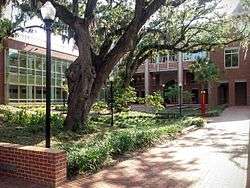
Additional to the main campus, the FSU Southwest Campus encompasses another 850 acres (3.4 km2) of land off Orange Drive. The southwest campus currently houses the Florida State University College of Engineering which is housed in a two building joint facility with the Florida Agricultural and Mechanical University. In addition to the College of Engineering, The Don Veller Seminole Golf Course and Club are located here and the Morcorm Aquatics Center. The FSU Research Foundation buildings as well as the National High Magnetic Field Laboratory are located in Innovation Park and the Alumni Village, family style student housing are located off Levy. Flastacowo Road Leads to the Florida State University Reservation, a student lakeside retreat on Lake Bradford.
In August a new 104-acre (0.4 km2) RecSports Plex opened located on Tyson Road. This intramural sports complex will become the largest in the collegiate world with twelve football fields, five softball fields, four club (soccer) fields as well as basketball and volleyball courts. The addition of the Southwest Tallahassee campus in recent years has expanded campus space to over 1,100 acres (4 km2).
Florida State University has seen considerable expansion and construction since T. K. Wetherell came into office in 2003. Numerous renovations as well as new constructions have been completed or are in the process of completion. These projects include student athletic fields, dormitories, new classroom space as well as research space. Currently the campus is undergoing a revival and beautification of the campus' main spaces.
Panama City
Florida State University Panama City is located 100 miles (160 km) from the main campus, beginning in the early 1980s. Since that time the campus has grown to almost 1,500 students supported by 15 bachelor's and 19 graduate degree programs.
FSU Panama City began offering full-time daytime programs in fall 2000. This scheduling, coupled with programs offered in the evenings, serves to accommodate the needs of its diverse student population. Over 30 resident faculty were hired to help staff the programs. Nestled among oaks along the waters of North Bay and only three miles from the Gulf of Mexico, the Florida State University Panama City campus offers upper-division undergraduate courses as well as some graduate and specialist degree programs.
Since opening in 1982, over 4,000 students have graduated from FSU Panama City with degrees ranging from elementary education to engineering. All courses are taught by faculty members from the main FSU campus. The satellite institution currently has a ratio of 25 students to each faculty member.[70]
Organization and administration
| College/school founding | |
|---|---|
| College/school | Year founded |
|
| |
| College of Arts & Sciences | 1901 |
| College of Human Sciences | 1901 |
| College of Education | 1901 |
| College of Music | 1901 |
| College of Social Work | 1928 |
| School of Dance | 1930 |
| College of Fine Arts | 1943 |
| College of Communication and Information | 1947 |
| School of Information | 1947 |
| Askew School of Public Administration and Policy | 1947 |
| Dedman School of Hospitality | 1947 |
| College of Business | 1950 |
| College of Nursing | 1950 |
| College of Law | 1966 |
| College of Social Sciences and Public Policy | 1973 |
| School of Theatre | 1973 |
| College of Criminology and Criminal Justice | 1974 |
| College of Engineering | 1983 |
| College of Motion Picture Arts | 1989 |
| College of Medicine | 2000 |
| School of Communication | 2009 |
| School of Communication Science and Disorders | 2009 |
| Jim Moran School of Entrepreneurship | 2017 |
| School of Physician Assistant Practice | 2017 |
As a part of the State University System of Florida, Florida State University falls under the purview of the Florida Board of Governors. However, a 13-member Board of trustees is "vested with the authority to govern and set policy for Florida State University as necessary to provide proper governance and improvement of the University in accordance with law and rules of the Florida Board of Governors".[71]
Sally McRorie became the provost of FSU in November 2015, and is responsible for day-to-day operation and administration of the university.[72]
Florida State University is divided into 16 colleges and more than 110 centers, facilities, labs and institutes offering more than 300 degree programs.[73] Florida State University offers Associate, Bachelor, Masters, Specialist, Doctoral, and Professional degree programs. The most popular Colleges by enrollment are Arts and Sciences, Business, Social Sciences, Education, and Human Science.[74]
The Florida State University College of Medicine operates using diversified hospital and community-based clinical education medical training for medical students. Founded on the mission to provide care to medically under served populations, the Florida State University College of Medicine for patient-centered care. The students spend their first two years taking basic science courses on the FSU campus in Tallahassee and are then assigned to one of the regional medical school campuses for their third- and fourth-year clinical training. Rotations can be done at one of the six regional campuses in Daytona Beach, Fort Pierce, Orlando, Pensacola, Sarasota or stay in Tallahassee if they so choose.[75]
Endowment
As of 2018, FSU's university-wide total financial endowment was valued at $681.4 million. Florida State University receives, in addition to state funding, financial support from the Florida State University Foundation, which had a financial endowment valued at $500.9 million as of June 30, 2018.[76] The endowment helps provide scholarships to students, support teaching and research, and fund other specific purposes designated by donors.
Seminole Boosters
Seminole Boosters, Inc., is designated as the Direct Support Organization for Florida State University athletics.[77] Contributors account for more than $14 million in annual funds, plus at least $15 million per year in capital gifts. The Seminole Boosters Scholarship Endowment has nearly $66 million under management, and the Boosters are involved with a wide range of enterprises including affinity programs, logos and licensing, game-day parking, concessions, the University Center Club, skybox management, and the construction of athletic facilities.[78]
Student government
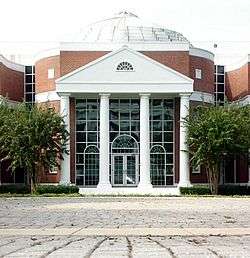
The Florida State University Student Government Association is the governing body of students who attend Florida State University, representing the university's nearly 43,000 undergraduate, graduate and professional students. The university's student government currently operates on a yearly $12.86 million budget, one of the largest student government budgets in the United States, and the money is allocated by the Finance Committee of the Legislative Branch.[79]
The student government was established in 1935 and consists of executive, judicial, and legislative branches.[80] The student government executive branch is led by the student body president and includes the student body vice President, student body treasurer, six agencies, seven bureaus, and executive secretaries within the Executive Office of the President.
The Student Senate is the legislative branch, and is composed of 80 senators who serve one-year terms. The student body elects the first half during each spring semester and the remaining half during the fall semester. The senators elect a senate president and senate president pro tempore once a year, after the fall election, to lead the Student Senate.[81]
The student government judicial branch has two major components: the Supreme Court of the Student Body (headed by a chief justice) and all elections related officials such as the supervisor of elections and the Elections Commission. The Supreme Court consists of seven second or third-year students at the FSU College of Law nominated by the student body president and confirmed by the Student Senate.[82] Each justice serves a "life-time" term, which extends through the individual justice's graduation and insulates the court from the politics of student government. The chief justice may appoint a marshal and clerk. The election commission is also composed of Florida State University College of Law students and it adjudicates all student government election complaints. The commission has five members, one of whom also serves as the commission chairman.
Academics

Florida State University aspires to become a top twenty-five public research university with at least one-third of its PhD programs ranked in the top 15 nationally.[83] The university owns more than 1,600 acres (6.4 km²) and is the home of the National High Magnetic Field Laboratory among other advanced research facilities. The university continues to develop in its capacity as a leader in Florida graduate research. Other milestones at the university include the first ETA10-G/8 supercomputer,[84] capable of 10.8 GFLOPS in 1989, remarkable for the time in that it exceeded the existing speed record of the Cray-2/8, located at the Lawrence Livermore National Laboratory by a substantial leap and the development of the anti-cancer drug Taxol.
Florida State University is divided into 16 colleges and schools including the Colleges of Applied Studies, Arts & Sciences, Business, Communication & Information, Criminology & Criminal Justice, Education, Engineering, Fine Arts, Human Sciences, Law, Medicine, Motion Picture Arts, Music, Nursing, Social Sciences & Public Policy, and Social Work, plus the Graduate School, Dedman School of Hospitality, and the Jim Moran School of Entrepreneurship. Florida State offers 104 baccalaureate degree programs, 112 master's degree programs, an advanced master's degree program, 12 specialist degree programs, 70 doctorate degree programs, and 3 professional degree programs.[85] The most popular Colleges by enrollment are Arts and Sciences, Business, Social Sciences, Education, and Human Science.[74]
A number of undergraduate academic programs at Florida State University are termed "Limited Access Programs". Limited Access Programs are programs where student demand exceeds available resources. Admission is thus restricted and sometimes extremely competitive. Examples of limited access programs include The Florida State University Film School, the College of Communication and Information, the College of Nursing, Computer Science, most of the majors in the College of Education, several majors in the College of Visual Arts, Theatre and Dance and all majors in the College of Business.[86]
Tuition
For the 2018–2019 academic year, tuition costs were:
- Undergraduate
- $215.55 per credit hour for in-state students, and $721.10 per credit hour for out-of-state students.[87] Total tuition/fees :$5,616 for in-state and $18,746 for out of state.[88]
- Graduate
- $479.32 per credit hour for in-state students, and $1,110.72 per credit hour for out-of-state students.[87] Total tuition/fees :$9,580 for in-state and $22,220 for out of state.[88]
- Law School
- $688.11 per credit hour for in-state students, and $1,355.18 per credit hour for out-of-state students.[87] Total tuition/fees :$20,644 for in-state and $40,656 for out of state.[89]
- Medical School
- $479.32 per credit hour for in-state students, and $1,110.72 per credit hour for out-of-state students.[87] Total tuition/fees per term :$8,536.86 (Cohort 1), $12,805.30 (Cohort 2), $8,492.86 (Cohort 3 & 4) for in-state students and $20,053.93 (Cohort 1), $30,080.90 (Cohort 2), $19,987.93 (Cohort 3 & 4) for out-of-state students.[90]
Admissions
| 2018 | 2017 | 2016 | 2015 | 2014 | |
|---|---|---|---|---|---|
| Applicants | 50,314 | 35,334 | 29,027 | 29,828 | 30,266 |
| Admits | 18,504 | 17,381 | 16,840 | 16,674 | 16,763 |
| Admit rate | 36.78% | 49.19% | 58.01% | 55.90% | 43.81% |
| Enrolled | 6,324 | 6,523 | 6,282 | 6,100 | 6,021 |
| SAT range | 1260–1360 | 1230–1340 | 1160–1290 | 1180–1300 | 1180–1290 |
| ACT range | 27–31 | 26–30 | 26–30 | 26–30 | 26–30 |
The middle 50% of the Fall 2019 freshmen class had a GPA range from 4.1 – 4.4; a SAT total range from 1250 to 1360 and an ACT range from 28 – 31.[92] The acceptance rates for admission in 2019 were 33.3% and 27.9% respectively for 47,565 freshman applicants and nearly 20,000 graduate school applicants.[92][93]
FSU's freshman retention rate for the class of 2023 is 93.1%.[94] In 2019, the university achieved a four-year graduation rate of 72%, the highest rate in the State University System of Florida and among the top 10 nationally.[95] The university has over an 80.0% six-year graduation rate compared to the national average six-year graduation rate of 59%.[96]
Enrollment
Florida State University students, numbering 41,551 in Fall 2019, come from more than 130 countries, and all 50 U.S. states.[8] The ratio of women to men is 57:43, and 22.6 percent are graduate and professional students.[8] Professional degree programs include Law, Medicine, Business Administration, Social Work, and Nursing.
| Undergraduate | Graduate | Florida | U.S. Census | |
|---|---|---|---|---|
| African American | 8.8% | 10.0% | 16.9% | 13.4% |
| Asian American | 2.6% | 3.3% | 2.9% | 5.8% |
| Caucasian American | 59.5% | 55.3% | 54.1% | 60.7% |
| Hispanic American | 21.9% | 11.9% | 25.6% | 18.1% |
| Multiracial American | 4.2% | 2.9% | 2.1% | 2.7% |
| Native American | 0.2% | 0.2% | 0.5% | 1.3% |
| International student | 1.6% | 14.7% | N/A | N/A |
| Not Reported | 1.1% | 1.7% | N/A | N/A |
In 2017, 7.1% of FSU students were international students. Of those, the most popular countries of origin were: China (20%), Panama 10.5%, India (6%), South Korea (5.4%), Colombia (5.1%), and Brazil (3.7%). In total, 2,974 international students enrolled at Florida State University.[99]
Miami-Dade, Broward, Palm Beach, Hillsborough, and Leon County make up the largest Florida counties for in-state students. The Miami metropolitan area accounts for the largest geographic origin of students and makes up 23.41% of the student body. Students from Georgia, Virginia, New York, New Jersey, North Carolina, Texas, Pennsylvania, and Maryland make up the largest states for out-of-state students.[100]
Rankings
| University rankings | |
|---|---|
| National | |
| ARWU[101] | 67-94 |
| Forbes[102] | 151 |
| THE/WSJ[103] | 208 |
| U.S. News & World Report[104] | 57 |
| Washington Monthly[105] | 81 |
| Global | |
| ARWU[106] | 201–300 |
| QS[107] | 448 |
| THE[108] | 251–300 |
| U.S. News & World Report[109] | 190 |
|
USNWR graduate school rankings[110] | |
|---|---|
| Business | 85 |
| Education | 47 |
| Engineering | 102 |
| Law | 50 |
| Medicine: Primary Care | 94-122 |
| Medicine: Research | 94–122 |
| Nursing: Doctorate | 62 |
|
USNWR departmental rankings[110] | |
|---|---|
| Biological Sciences | 112 |
| Chemistry | 67 |
| Clinical Psychology | 27 |
| Computer Science | 82 |
| Criminology | 5 |
| Earth Sciences | 99 |
| Economics | 59 |
| English | 67 |
| Fine Arts | 42 |
| History | 69 |
| Library and Information Studies | 12 |
| Mathematics | 74 |
| Physics | 47 |
| Political Science | 40 |
| Psychology | 60 |
| Public Affairs | 25 |
| Public Health | 113 |
| Social Work | 33 |
| Sociology | 47 |
| Speech-Language Pathology | 20 |
| Statistics | 44 |
For 2020, U.S. News & World Report ranked Florida State University as the 18th best public university in the United States, and 57th overall among all national universities, public and private.[111]
For 2019, the FSU College of Business was ranked 27th undergraduate program among all public universities and 44th among all national universities.[112]
Florida State is ranked the 16th best doctorate-granting university in the US for the highest amount of African American doctorate recipients by the National Science Foundation.[113]
The FSU College of Medicine has been ranked among the nation's top 10 for Hispanic and Latino American students. In 2014, Hispanic Business ranked the med school eighth, the same as last year. The college was ranked seventh in 2012, seventh in 2009 and ninth in 2007. The magazine annually ranks colleges of business, engineering, law and medicine. Rankings are based on percentage of Hispanic student enrollment; percentage of Hispanic faculty members; percentage of degrees conferred upon Hispanics; and progressive programs aimed at increasing enrollment of Hispanic students.[114]
In 2012, the Princeton Review and USA Today ranked Florida State the 4th "Best Value" public university in the nation. In 2012, Florida State was ranked among universities as having the most financial resources per student.[115] Florida State is ranked the 29th top college in the United States by Payscale and CollegeNet's Social Mobility Index college rankings(2014).[116]
Florida State University is one of the two original state-designated "preeminent" universities in Florida.[117]
Florida State University receives the highest National Science Foundation research and development award in the state.[118]
Honors Program

Florida State University has a nationally recognized honors program.[119] The University Honors Office supports the university's long tradition of academic excellence by offering two programs, the University Honors Program and the Honors in the Major Program, which highlight the institution's strengths in teaching, research, and community service. The Honors Program also offers special scholarships, internships, research, and study abroad opportunities.
Admission into the University Honors Program is by invitation only. The average academic profile of students that were offered honors invitations in 2015 was as follows: 4.2 weighted GPA; 32 ACT composite; 2080 SAT total. For the Honors in the Major Program students, the University Honors Office requires that prospective students have at least sixty semester hours and at least a 3.2 cumulative FSU GPA.[120] The Honors program offers students housing in Landis Hall and Gilchrist Hall. Landis Hall is the traditional home of Honors students since 1955, which is situated on Landis Green at the heart of FSU's main campus. Gilchrist Hall also houses Honors students and is located adjacent to Landis Hall.
Honors scholarships
The Presidential Scholars Program is the premier undergraduate scholarship program at Florida State University. The program provides four years of support and is open to high school seniors who are admitted into Florida State University's Honors Program. The total award package for Presidential Scholars is $31,200, plus an out-of-state tuition waiver. This includes the $9,600 Presidential Scholarship distributed over four years and a $9,600 Admissions Scholarship distributed over four years. It also includes $12,000 for educational enrichment opportunities including international experiences such as Study Abroad and Global Scholars, research and creative projects, service learning projects or public service, internships, and entrepreneurial development. Support and guidance is offered through the Honors Program, Center for Undergraduate Research and Academic Engagement and the Office of National Fellows.[121]
International Programs
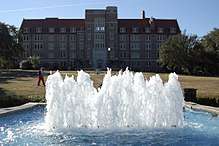
Florida State University's International Programs (FSU IP) is ranked 11th in the nation among university study abroad programs. Every year Florida State consistently sends over 2,379 students across the world to study in multiple locations.[122][123] As a student of IP, students are able to take classes that meet their major and/or minor requirements, study with experts in their field, and earn FSU credit.
Florida State has four permanent study centers providing residential and academic facilities in London; Florence, Italy; Valencia, Spain; and Panama City, Panama.[124]
Florida State University is well known for its undergraduate and graduate study abroad options: according to Uni in the USA, "the large numbers of students that study abroad nicely complement the students that study here from abroad."[125]
Career placement

The Florida State University Career Center is located in the Dunlap Success Center. Its mission is to provide comprehensive career services to students, alumni, employers, faculty/staff and other members of the FSU community. These services involve on and off-campus job interviews, career planning, assistance in applying to graduate and professional schools, internships, fellowships, co-op placements, research, and career portfolio resources.[126] The Career Center offers workshops, information sessions, and career fairs. Staff at the FSU Career Center advise students and alumni regarding resumes and portfolios, tactics for job interviews, cover letters, job strategies and other potential leads for finding employment in the corporate, academic, and government sectors.
The ProfessioNole program offers students the chance to reach out to professionals throughout the community, country, and world and learn more about their field's industry demands, career expectations, job outlook, and employment opportunities. Both alumni and friends of the university participate in ProfessioNole, making themselves available for student inquiries.[127] SeminoleLink is The Career Center's registration system linking students and alumni directly with employers. SeminoleLink is part of the NACElink Network, the largest network of career services and recruiting professionals in the world.[128]
Center for Academic Retention & Enhancement
The FSU Center for Academic Retention and Enhancement (CARE) is a multifaceted center that provides preparation, orientation, and academic support programming for first-generation college students who are disadvantaged by economical and educational circumstances. CARE provides academic support services such as a dedicated tutoring and computer lab as well as advising and life coaching. It was created in 2000 after combining various minority academic programs, services, and scholarships into one entity which has enrolled over 5,500 students as of 2017.[129]
As of 2017, CARE had a first-year retention rate of 97 percent and had an 81 percent six-year graduation rate.[130] The average first term college GPA of CARE students throughout the inception of the program is 3.1.
The Summer Bridge Program (SBP) is an alternative admission program for disadvantaged first generation students.[131] The seven-week program helps students transition from high school by providing an early move-in date for easier acclimation, along with group activities managed by peer ambassadors who have already gone through the program.
The Unconquered Scholars Program provides additional support services for students who previously classified and experienced foster care, homelessness, relative care, or ward status.
Florida State University Libraries
The Florida State University Libraries house one of the largest collections of documents in the state of Florida. The Libraries' collections include over 3.75 million volumes, with a website offering access to more than 400 databases, 200,000 e-journals, and over 1.9 million e-books.[132] In total, Florida State has thirteen libraries and millions of books and journals to choose from. The collection covers virtually all disciplines and includes a wide array of formats – from books and journals to manuscripts, maps, and recorded music. Increasingly collections are digital and are accessible on the Internet via the library web page or the library catalog. The FSU Library System also maintains subscriptions to a vast number of online databases which can be accessed from any student account on or off campus.[133] The current dean of the Library System is Gale Etschmaier, who oversees a $19.9 million annual budget recorded in 2017.[132]
- Libraries
The Robert M. Strozier Library is Florida State's main library. It is located in the historic central area of the campus adjacent to Landis Green and occupies seven floors. Strozier's collections focus on Humanities, Social Sciences, Business, and Education. The facility has been renovated several times. When opened, it consisted off three floors; an expansion added five floors plus two subground floors to the rear of the original building. In 2008, the lower floor reopened as the graduate- and faculty-focused Scholars Commons. In 2010, the main floor was transformed into an undergraduate-focused Learning Commons. The most recent renovation added smart study rooms, an enlarged computer area, new circulation areas, a tutoring center, and the nation's first double-sided Starbucks.[134] Strozier also houses the Special Collections and Archives division and Heritage Protocol. Strozier Library is open 24-hours on weekdays during the fall and spring semesters. The library closes early on Friday and Saturday nights and maintains decreased hours during the summer semester.[135]
The newer Paul A. M. Dirac Science Library is the main science library for Florida State University and houses over 500,000 books. Located on FSU's Legacy Walk farther west on campus, Dirac Library is smaller than Strozier at three stories. Dirac offers nearly 800 seats and provides 80 desktop computers (PC and Mac) and 80 laptop computers(PC and Mac) for use by students.[136] Dirac also offers 8 wireless Air Media Displays and 2 innovative MondoPad displays. There are over 35 individual and group study rooms that can be reserved online.[136] The library building is also home to the FSU School of Computational Science and Information Technology.[137] The library also houses a collection of materials principally related to Dirac's times at FSU and Cambridge University.[138] Dirac has been renovated in 2015 with new and improved amenities, technology, and seating.[136]
The Claude Pepper Center on campus is home to a think tank devoted to intercultural dialogue and the Mildred and Claude Pepper Library. It is located in what was originally the Florida State College for Women Library, which served as studios for WFSU-TV prior to construction of its current facility. The library contains a wide collection of documents, books, photographs, and recordings formerly belonging to Claude Pepper which are available to researchers. The Center is also home to a collection of former Florida Governor Rubin Askew.[139] The Center is headed by FSU alumnus Larry Polivka, PhD.[140] The goal of the Claude Pepper Center is to further the needs of elderly Americans and has worked towards this goal since it opened in 1998.[141]
The Warren D. Allen Music Library occupies 18,000 square feet of space within the Housewright Music Building in the Florida State University College of Music and serves as a repository for over 150,000 scores, sound recordings (17,000 albums and over 17,000 CDs), video recordings, books, periodicals, and microforms. The library was founded in 1911.[142]
The Harold Goldstein Library on the main campus houses a collection of approximately 82,000 books, videos and CDs relating to library and information science, information technology, and juvenile literature.[143][144] The largest part of the collection consists of professional and reference materials as well as juvenile and easy books.
The Florida State University College of Law Research Center houses the official library of the Florida State University College of Law. Located in B. K. Roberts Hall, the library has holdings consisting of over 500,000 volumes of which contain the basics of US law, English Common Law, and International Law. The library also maintains subscriptions to several law-specific databases which can be accessed by students.[145]
Museums

The Ringling, the State Art Museum of Florida, is located in Sarasota, Florida and is Administered by Florida State University[146] It was established in 1927 as the legacy of Mable and John Ringling for the people of Florida. The institution offers twenty-one galleries of European paintings as well as Cypriot antiquities and Asian, American, and contemporary art. The museum's art collection currently consists of more than 10,000 objects that include a wide variety of paintings, sculpture, drawings, prints, photographs, and decorative arts from ancient through contemporary periods and from around the world. The most celebrated items in the museum are 16th-, 17th-, and 18th-century European paintings, including a world-renowned collection of Peter Paul Rubens paintings.[147] The Ringling Museum collections constitute the largest university museum complex in the United States.[148] In 2014 the Ringling was selected as the second most popular attraction in Florida by the readers of USAToday Travel.[149]
In all, more than 150,000 square feet (14,000 m2) have been added to the campus, which includes the art museum, circus museum, and Cà d'Zan, the Ringlings' mansion, which has been restored, along with the historic Asolo Theater. New additions to the campus include the Visitor's Pavilion, the Education, Library, and Conservation Complex, the Tibbals Learning Center complete with a miniature circus, and the Searing Wing, a 30,000-square-foot (2,800 m2) gallery for special exhibitions attached to the art museum.[150]
Florida State University also maintains the FSU Museum of Fine Arts (MoFA) in Tallahassee. The MoFA permanent collection consists of over 4000 items in 18 sub-collections ranging from pre-Columbian pottery to contemporary art. The museum has a significant number of works of art on paper, including prints of artists as well known as Rembrandt and Pablo Picasso.[151]
Research
As one of the two primary research universities in Florida, Florida State University has long been associated with basic and advanced scientific research.[152] Today the university engages in many areas of academic inquiry at the undergraduate,[153] graduate[154] and postdoctoral levels.[155]
Florida State University was awarded $268.5 million in annual research expenditures, in sponsored research in fiscal year 2016.[156] FSU is one of the top 15 universities nationally receiving physical sciences funding from the National Science Foundation.[157]
Florida State currently has 19 graduate degree programs in interdisciplinary research fields.[158] Interdisciplinary programs merge disciplines into common areas where discoveries may be exploited by more than one method. Interdisciplinary research at FSU covers traditional subjects like chemistry, physics and engineering to social sciences.
National High Magnetic Field Laboratory
The National High Magnetic Field Laboratory (NHMFL) or "Mag Lab" at Florida State develops and operates high magnetic field facilities that scientists use for research in physics, biology, bioengineering, chemistry, geochemistry, biochemistry, materials science, and engineering. It is the only facility of its kind in the United States and one of only nine in the world. Fourteen world records have been set at the Mag Lab to date.[159] The Magnetic Field Laboratory is a 440,000 sq. ft (40,877 square meter) complex employing 507 faculty, staff, graduate, and postdoctoral students. This facility is the largest and highest powered laboratory of its kind in the world and produces the highest continuous magnetic fields.
MIT Contest of lab award
In 1990 the National Science Foundation awarded Florida State University the right to host the new National High Magnetic Field Laboratory. Rather than improve the existing Francis Bitter Magnet Laboratory controlled by the Massachusetts Institute of Technology (MIT) together with a consortium of other universities, the NSF elected to move the Lab mainly to Florida State University, with a smaller facility at the University of Florida.[159] The award of the laboratory was contested by MIT in an unprecedented request to the NSF for a review of the award.[160] The NSF denied the appeal, explaining that the superior enthusiasm for and commitment to the project demonstrated by Florida State led to the decision to relocate the lab.[161]
Large Hadron Collider
After decades of planning and construction the Compact Muon Solenoid (CMS) is a next generation detector for the new proton-proton collider (7 TeV + 7 TeV) called the Large Hadron Collider (LHC) which is now operational in the existing 17 mi (27 km) circular tunnel near Geneva, Switzerland at CERN, the European Laboratory for Particle Physics. Florida State University faculty members collaborated in the design, construction and operation of the LHC, with some components assembled at Florida State and shipped to CERN for installation.[162] Florida State faculty contributed to several areas of the CMS, especially the electromagnetic calorimeter and the hadron calorimeter.[163]
High-Performance Materials Institute
The High-Performance Materials Institute (HPMI) is a multidisciplinary research institute at Florida State University. Currently, HPMI is involved in four primary technology areas: High-Performance Composite and Nanomaterials, Structural Health Monitoring, Multifunctional Nanomaterials Advanced Manufacturing and Process Modeling.
Over the last several years, HPMI has proven a number of technology concepts that have the potential to narrow the gap between research and practical applications of nanotube-based materials. These technologies include magnetic alignment of nanotubes, fabrication of nanotube membranes or buckypapers, production of nanotube composites, modeling of nanotube-epoxy interaction at the molecular level, and characterization of SWNT nanocomposites for mechanical properties, electrical conductivity, thermal management, radiation shielding and EMI attenuation. HPMI personnel also established Florida's first National Science Foundation (NSF) Industry/University Cooperative Research Center (IUCRC).
In 2006, the Florida Board of Governors designated HPMI as a Center of Excellence in Advanced Materials and awarded $4 million to further HPMI's efforts in technology transfer, economic development and work force training. Under its cluster hiring program, FSU has awarded the HPMI team with an additional $4 million to recruit and hire some of the nation's top researchers in Materials. HPMI personnel moved into the new $20 million, 45,000 square foot Materials Research Building, which houses the latest state-of-the art equipment and facilities for materials research, especially designed for research in nanomaterials.[164]
The Center for Advanced Power Systems
Florida State University's Center for Advanced Power Systems (CAPS) has become the first university test site accredited by the U.S. Navy to perform high-powered simulations as the center develops next-generation shipboard power technology.
The Center for Advanced Power Systems is a multidisciplinary research center organized to perform basic and applied research to advance the field of power systems technology. CAPS' emphasis is on application to electric utility, defense, and transportation, as well as, developing an education program to train the next generation of power systems engineers. The research focuses on electric power systems modeling and simulation, power electronics and machines, control systems, thermal management, cyber-security for power systems, high temperature superconductor characterization and electrical insulation research. With support from the U.S. Navy, Office of Naval Research (ONR) and the U.S. Department of Energy, CAPS has established a unique test and demonstration facility with one of the largest real-time digital power systems simulators along with 5 MW AC and DC test beds for hardware in the loop simulation. The center is supported by a research team composed of dedicated and highly skilled researchers, scientists, faculty, engineers, and students, recruited from across the globe, with strong representation from both the academic/research community and industry.[165]
In January 2015, Florida State University's Center for Advanced Power Systems has unveiled a new 24,000-volt direct current power test system, the most powerful of its kind available at a university research center throughout the world. The new test facility is the latest piece of the center's PHIL testing program. It has a 24,000-volt direct current with a capacity of 5 megawatts, making it the most powerful PHIL system of its kind at a university research center worldwide. To create the new system, the center put together four individual 6 kilovolt, 1.25 megawatt converters that can be arranged in any combination, in series or parallel connection, to form an extremely flexible test bed for medium voltage direct current (MVDC) system investigations.[166]
CAPS researchers are also collaborating with Virginia Tech on a project for the U.S. Office of Naval Research to evaluate the performance of an electrical impedance measurement unit (IMU) developed by Virginia Tech and to be shipped to CAPS for testing. The purpose of an IMU is to probe a power system for its impedance characteristics to establish criteria for stable operation of the system.
CAPS is a long-term contractor with the U.S. Navy, which is working to develop an all-electric ship. The Navy has also committed funding to study design and performance of fault current limited MVDC systems and other operational aspects of MVDC systems.
Coastal and Marine Laboratory
The FSU Coastal and Marine Laboratory is located about 45 miles (72 km) from the main campus in Tallahassee. It is on the coast of St. Teresa, Florida, between Panacea and Carrabelle, on Apalachee Bay, 8 acres (32,000 m2) of which is right on the water and the remaining 70 acres (280,000 m2) of which is directly across the road. The mission of the FSUCML is to conduct innovative, interdisciplinary research focused on the coastal and marine ecosystems of the northeastern Gulf of Mexico, with a focus on solving the ecological problems faced by the region by providing the scientific underpinnings for informed policy decisions. Research is conducted by faculty in residence and by those from the main campus, as well as by faculty, postdoctoral, graduate, and undergraduate investigators from FSU and other universities throughout the world.[167]
Florida State University established its first marine laboratory, the Oceanographic Institute, in 1949, on 25 acres (100,000 m2) on the harbor side of the peninsula that forms Alligator Harbor, which maintained a substantial research effort throughout the 1950s and 1960s. Other marine stations maintained by Florida State University until 1954 included one at Mayport, on the St. Johns River near Jacksonville, which conducted research related to the menhaden and shrimp fisheries and oceanographic problems of the Gulf Stream and the mouth of the St. John's River, and one on Mullet Key at the mouth of Tampa Bay, which studied red tide.
In the late 1960s, FSU moved the lab to its current location west of Turkey Point, on land donated by Edward Ball, the founder of the St. Joe Paper Company, and changed its name to The Edward Ball Marine Laboratory. In 2006, the lab became known as The Florida State University Coastal and Marine Laboratory (FSUCML), a name that better reflects the expanded programmatic base of its research, education, and outreach missions.[168]
Student life
Traditions
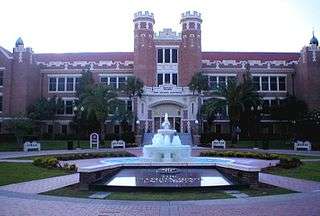
The university's colors are garnet and gold.[169] The colors of garnet and gold represent a merging of the university's past. While the school fielded a football team as early, or earlier than 1899,[170] in 1902, 1903 and 1905 the team won football championships wearing purple and gold uniforms.[21][171] The following year, the college student body selected crimson as the official school color. The administration in 1905 took crimson and combined it with the recognizable purple of the championship football teams to achieve the color garnet. After World War II the garnet and gold colors were first worn by a renewed football team in a 14–6 loss to Stetson University on October 18, 1947. Florida State University's marching band is the Marching Chiefs.
Alma mater
The alma mater for Florida State University was composed by Charlie Carter in 1956.[172]
The most popular songs of Florida State University include:
- Alma Mater – "High O'er Towering Pines"
- Hymn – "Hymn To the Garnet and Gold"
- Fight Song – "FSU Fight Song"
Residential life
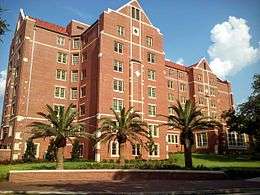
Florida State University provides 6,733 undergraduate and graduate students with housing as well as living–Learning Communities (LLC) on the main campus. This number will soon be expanded to 7,283 with new housing projects.[173] Florida State University is a traditional residential university wherein most students live on campus in university residence halls or nearby in privately owned residence halls, apartments and residences. Florida State currently has 18 residence halls on campus, housing undergraduate, graduate and international students. FSU offers suite-style and apartment-style residence halls. Students who are active members of the FSU Greek System may live in chapter housing near campus.[174] There is also a vast amount of off-campus housing options throughout Tallahassee for students to choose from.
Renovated historic student housing residence halls located on the eastern half of campus include Broward, Bryan, Cawthon, Gilchrist, Jennie Murphree, Landis and Reynolds. Deviney, Dorman, Magnolia, and Azalea Halls are the newest residence halls, also located on the Easter half of campus. There are three new residence hall complexes, Ragans and Wildwood, located near the athletic quadrant; and Degraff Hall, located right across West Tennessee Street. Smith, McCollum and Salley Halls are located in the northwestern quadrant. On-campus housing for single graduate students includes Rogers Hall, Ragans Hall, Traditions Hall, and McCollum Hall.[175]
Student clubs and activities
Florida State University has more than 700 organizations and clubs for students to join.[176] They range from cultural and athletic to philanthropy, including Phi Beta Kappa, AcaBelles, Garnet and Gold Scholar Society, Marching Chiefs, Garnet Girls Competitive Cheerleading, Florida State Golden Girls, FSU Pow Wow, FSU Majorettes, Hillel at FSU, Seminole Flying Club, No Bears Allowed, FSU Student Foundation, InternatioNole, Student Alumni Association, Hispanic/Latino Student Union, Relay For Life, The Big Event at FSU, Por Colombia, Quidditch at FSU, and the Men's Soccer Club. All organizations are funded through the SGA and many put on events throughout the year. Students may create their own registered student organization if the current interest or concern is not addressed by the previously established entities.
Fitness & Intramural Sports
The Bobby E. Leach Student Recreation Center is a 120,000 square foot fitness facility located right in the heart of campus. Construction on the Center was completed in 1991.[177] The Leach Center has three regulation-size basketball courts on the upper level with the third court being designated for other sports such as volleyball, table tennis, and badminton. It also has five racquetball & squash courts for recreational matches and an indoor track overlooking the pool on the third level of the facility.
The Leach Pool is a 16-lane by 25-yard indoor swimming facility with two 1-meter and two 3-meter diving boards. A complete spa area is located just off the pool deck and is equipped with two whirlpools, two steam rooms, and a sauna. The leach center provides over 100 free group fitness classes offered weekly along with personal training provided by NSCA-certified personal trainers.[178]
Florida State University also has an intramural sports program.[179] Sports clubs include equestrian and water sailing. The clubs compete against other Intercollegiate club teams around the country. Intramural sports include flag football, basketball, recreational soccer, volleyball, sand volleyball, softball, swimming, kickball, mini golf, team bowling, tennis, ultimate frisbee, wiffle ball, dodge ball, battleship, college pick em, innertube water polo, kan jam, spikeball, and wallyball.[180]
A new area of intramural sports fields, named the 104-acre (0.4 km2) RecSports Plex, was opened in September 2007.[181] This intramural sports complex is the largest in the nation with twelve football fields, five softball fields, four soccer fields, and basketball and volleyball courts.[181]
Entertainment
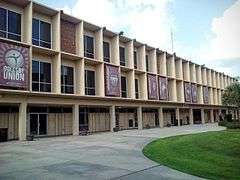
Crenshaw Lanes is a twelve lane bowling alley located in the Oglesby Student Union and it includes ten full sized billiard tables. It has been at FSU since 1964. The interior has been completely renovated for spring 2015.[182]
Club Downunder hosts entertainment acts such as bands and comedians.[183] Past bands that have come through Club Downunder include The White Stripes, Modest Mouse, The National, Girl Talk, Spoon, Soundgarden, She Wants Revenge, Cold War Kids, Yeah Yeah Yeahs, and Death Cab for Cutie. All shows that take place at Club Downunder are free for FSU students.[183]
The Askew Student Life Center is home to the Student Life Cinema.[184] It features five to six nights a week playing movies, documentaries, indies, foreign films, and restored cinema movies. Movies are selected by an all-student committee and are free to all currently enrolled FSU students.[184]
The Student Life Center offers a cybercafe with computers for Internet surfing and computer games, as well as board games. A coffee shop called Reel Coffee sells snacks and drinks in the cybercafe. The cybercafe hosts Super Smash Bros. tournaments and other gaming tournaments.[185]
Florida State's Reservation is a 73-acre (300,000 m2) lakeside recreational area located off campus.[186] This university retreat on Lake Bradford was founded in 1920 as a retreat for students when FSU was the state college for women between 1905 and 1947. The original name for the retreat was Camp Flastacowo.[187]
Florida State University is one of two collegiate schools in the country to have a circus.[188] The FSU Flying High Circus is a three-ring circus that has performances during the Fall semester (for Parents' Weekend) and Spring semester (their annual homeshow). The circus, founded in 1947 by Jack Haskin, in an extracurricular activity under the Division of Student Affairs that any FSU student may join. Student performers in the circus practice daily, much like any other school sport. The performers help rig their equipment and sew their own costumes. Performances occur in April under the Big Top circus tent.[189]
Greek life
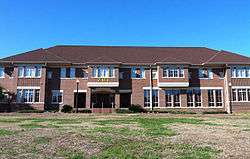
14% of undergraduate men are in a fraternity and 23% of undergraduate women are in a sorority.[190][191] The Office of Greek Life at Florida State University encompasses the Interfraternity Council (IFC), Panhellenic Council (NPC), Multicultural Greek Council (MGC), and the National Pan-Hellenic Council (NPHC). The Order of Omega and Rho Lambda Honor Societies also have chapters at Florida State.
The Interfraternity Council (IFC) comprises 22 fraternities. The Panhellenic Association is made up of 17 sororities and over 4,000 women.
The Multicultural Greek Council consists of 11 cultural organizations (Latino, Asian, South Asian, etc.).[192] The National Pan-Hellenic Council comprises 8 historically black organizations.
In 2017, university president John E. Thrasher suspended activities at all of the university's 55 fraternities and sororities, days after two unrelated incidents in which a 20-year-old fraternity pledge died following a party at an off-campus house and a 20-year-old fraternity member was arrested on charges of cocaine trafficking. Thrasher said that Greek activities would be permitted to resume after the university developed new policies, saying "The message is not getting through" and calling for a major culture shift.[193][194]
| Fraternities[195] | Sororities[196] | ||||
|---|---|---|---|---|---|
|
|||||
Reserve Officer Training Corps
Florida State University's Reserve Officer Training Corps is the official officer training and commissioning program at Florida State University. Dating back to Civil War days, the ROTC unit at Florida State University is one of four collegiate military units with permission to display a battle streamer, in recognition of the military service of student cadets during the Battle of Natural Bridge in 1865.[197]
The Reserve Officer Training Corps offers commissions for the United States Army and the United States Air Force. The Reserve Officer Training Corps at Florida State is currently located at the Harpe-Johnson Building.[198]
The Reserve Officer Training Corps at Florida State University offers training in the military and aerospace sciences to students who desire to perform military service after they graduate. The Departments of the Army and Air Force each maintain a Reserve Officers Training Corps and each individual department (Department of Military Studies for the Army; Department of Aerospace Studies for the Air Force) has a full staff of active duty military personnel serving as instructor cadre or administrative support staff. Florida State University is also a cross-town affiliate with Florida A&M University's Navy ROTC Battalion, allowing FSU students to pursue training in the naval sciences for subsequent commissioning as officers in the Navy or Marine Corps.[199]
Campus and area transportation
The FSU campus is served by eight bus routes of the Seminole Express Bus Service. The Seminole Express Bus Service provides transportation to, around, and from campus to the surrounding Tallahassee areas for Faculty, Staff, Students and Visitors. All students, faculty and staff can also ride any StarMetro bus throughout the City of Tallahassee for free by swiping a valid FSUCard.[200] FSU also provides other campus services, including Spirit Shuttle (during football games), Nole Cab, S.A.F.E. Connection, and Night Nole nighttime service.[201]
Florida State University is also served by the Tallahassee International Airport, which is located in the Southwest portion of Tallahassee and has daily services to Miami, Fort Lauderdale, Orlando, Tampa, Atlanta, Charlotte, and Dallas-Fort Worth.[202]
Student media
The campus newspaper, the FSView & Florida Flambeau, is 100 years old now and publishes weekly during the summer and semiweekly on Mondays and Thursdays during the school year following the academic calendar. After changing hands three times in 13 years, the FSView was sold to the Tallahassee Democrat in late July 2006, making it part of the Gannett chain.[203] This exchange was allowed because the FSView had been for a long time a for-profit business that was not legally associated with Florida State University. Since most collegiate newspapers are supported by their colleges, this was also among the first times that a major corporation had acquired a college newspaper.
FSU operates two television stations, WFSU and WFSG,[204] and three radio stations, WFSU-FM, WFSQ-FM and WFSW-FM.[205] FSU operates a fourth radio station, WVFS (V89, "The Voice", or "The Voice of Florida State"), as an on-campus instructional radio station staffed by student and community volunteers.[206] WVFS broadcasts primarily independent music as an alternative to regular radio.
The English Department publishes a literary journal, The Southeast Review, founded in 1979 as Sundog.[207]
Athletics

The school's athletic teams are called the Seminoles, derived from the Seminole people. The name was chosen by students in 1947 and is officially sanctioned by the Seminole Tribe of Florida;[208] the Seminole Nation of Oklahoma has taken no official position regarding the university's use of the name.[209] Florida State's athletes participate in the NCAA's Division I (Bowl Subdivision for football) and in the Atlantic Coast Conference.

For the 2017–18 school year, the Florida State Athletics Department budgeted $103.2 million for its sports teams and facilities and currently brings in over $121.3 million in revenues.[210][211] Florida State University is known for its competitive athletics in both men's and women's sports competitions. The men's program consists of baseball, basketball, cross country running, football, golf, swimming, tennis, and track & field. The women's program consists of basketball, cross country running, golf, soccer, softball, swimming, tennis, track & field, and volleyball. FSU's Intercollegiate Club sports include bowling, crew, rugby, soccer and lacrosse. Harkins Field is an artificial turf field that is home to the lacrosse team as well as serving as the practice field for the Marching Chiefs of the College of Music and the football team. In 2019, football generated 46.7% of the revenue, basketball, almost 10%, the remainder by the other 16 sports. 22% of football income is from the media.[212]
There are two major stadiums and an arena within FSU's main campus: Doak Campbell Stadium for football, Dick Howser Stadium for men's baseball, and the Donald L. Tucker Center for men's and women's basketball. The Mike Long Track is the home of the national champion men's outdoor track and field team.[213] H. Donald Loucks courts at the Speicher Tennis Center is the home of the FSU tennis team. By presidential directive the complex was named in honor of Lieutenant Commander Michael Scott Speicher, a graduate of Florida State University and the first American casualty during Operation Desert Storm.[214][215] The Seminole Soccer Complex is home to women's soccer. It normally holds a capacity of 1,600 people but has seen crowds in excess of 4,500 for certain games. The home record is 4,582 for the 2006 game versus the University of Florida.[216] The FSU women's softball team plays at the Seminole Softball Complex; the field is named for JoAnne Graf, the winningest coach in softball history.[217]
Florida State's traditional rivals in all sports include the University of Florida Gators, the University of Miami Hurricanes and the University of Virginia Cavaliers with a battle for the Jefferson–Eppes Trophy. The Jefferson–Eppes Trophy is exchanged between the University of Virginia and Florida State University after each football competition in recognition of the common roots shared by the two schools. Rivalries in some other sports also exist, including the Georgia Tech Yellow Jackets in baseball and the Duke University Blue Devils in basketball.
Florida State University has been penalized seven times by the NCAA for major infractions for the period 1968 through 2009.[218] These infractions range from improper recruiting of student-athletes, failure to investigate adequately to academic fraud. FSU has been penalized by the NCAA according to each violation of rules.
Seminole baseball
Seminole baseball is one of the most successful collegiate baseball programs in the United States having been to 20 College World Series', and having appeared in the national championship final on three occasions (falling to the University of Southern California Trojans in 1970, the University of Arizona Wildcats in 1986, and the University of Miami Hurricanes in 1999).[219] Under the direction of Head Coach No. 11 Mike Martin (FSU 1966), Florida State is the second-winningest program in the history of college baseball.[219] Since 1990, FSU has had more 50 win seasons, headed to more NCAA Tournaments (19 Regional Tournaments in 20 years), and finished in the top 10 more than any team in the United States.[219] Since 2000, FSU is the winningest program in college baseball with more victories and a higher winning percentage in the regular season than any other school.[219]
Seminole football
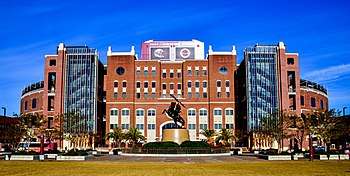
The Florida State Seminoles football program has played in 49 bowl games, won three consensus national championships, eighteen Atlantic Coast Conference (ACC) championships, six ACC division titles, produced 218 All-Americans, 47 National Football League (NFL) first-round draft choices, and three Heisman Trophy winners. The Seminoles have achieved three undefeated seasons and finished ranked in the top five of the AP Poll for 14 straight years from 1987 through 2000. The Florida State Seminoles are one of the 120 NCAA Division I FBS collegiate football teams in America.
The Seminoles' home field is Bobby Bowden Field at Doak Campbell Stadium, which has a capacity of 79,560.[220] The stadium first opened in 1950 with a capacity of 15,000. In 2015, construction began on a project to completely renovate Doak Campbell Stadium as part of the $250 million Florida State Seminoles Champions Campaign to improve all aspects of athletics. The project added new premium outdoor seating sections, structural repairs, a repainting of the stadium, and updated sky box suites. The most recent addition of the stadium was completed in 2016 which replaced two video boards. The 9,368 square feet north video board is the largest video board in the state of Florida and the second largest in the nation. The stadium is popularly known as "Doak."
Florida State University fielded its first official varsity football team in the fall of 1902 until 1904, which were then known as "The Eleven".[170][221] The team went (7–6–1) over the 1902–1904 seasons posting a record of (3–1) against their rivals from the Florida Agricultural College in Lake City. In 1904 the Florida State football team became the first ever state champions of Florida after beating both the Florida Agricultural College and Stetson University.[221] The football team and all male students subsequently moved to the newly opened University of Florida in Gainesville in 1906 as a result of the 1905 Buckman Act. Football returned to Florida State after World War II in 1947.
Under head coach Bobby Bowden, the Seminole football team became one of the nation's most competitive college football teams.[222] The Seminoles played in five national championship games between 1993 and 2001 and won the championship in 1993 and 1999. The FSU football team was the most successful team in college football during the 1990s, boasting an 89% winning percentage.[223] Bobby Bowden would retire with the record for most all-time career wins in Division I football.[224] Jimbo Fisher succeeded Bowden as head coach in 2010. FSU football has introduced a number of players into the NFL.
Seminole track and field
The FSU men's Track & Field team won the Atlantic Coast Conference championship four times running, in addition to winning the NCAA National Championship three consecutive years.[213][225][226][227] In 2006 Head Coach Bob Braman and Associate Head Coach Harlis Meaders helped lead individual champions in the 200 m (Walter Dix), the triple jump (Raqeef Curry), and the shot put (Garrett Johnson). Individual runners-up were Walter Dix in the 100 m, Ricardo Chambers in the 400 m, and Tom Lancashire in the 1500 m. Others scoring points in the National Championship were Michael Ray Garvin in the 200 m (8th), Andrew Lemoncello in the 3000 m steeplechase (4th), Raqeef Curry in the long jump (6th), and Garrett Johnson in the discus (5th).[228] In 2007, FSU won its second straight men's Track & Field NCAA National Championship when Dix became the first person to hold the individual title in the 100 m, 200 m, and 400 m at the same time.[229] Florida State has had 34 athletes compete at the Olympics in their respective events, most recently having ten athletes compete in the 2008 Beijing Olympics. Those athletes included Gonzalo Barroilhet (Chile), Ricardo Chambers (Jamaica), Refeeq Curry (USA), Walter Dix (USA), Brian Dzingai (Zimbabwe), Tom Lancashire (England), Andrew Lemoncello, (England), Ngoni Makusha (Zimbabwe), Barbara Parker (England), and Dorian Scott (Jamaica). Walter Dix earned two bronze medals (100 m & 200m) at the Olympic Games.
Faculty
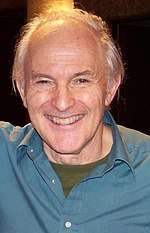
Florida State University currently employs 2,548 faculty members and over 8,133 staff.[230][7] Florida State's more than 41,900 students have the opportunity to work and study among faculty that includes a Nobel Laureate, three active members of the National Academy of Sciences, two active members of the National Academy of Engineering, two active members of the American Academy of Arts and Sciences, two Pulitzer Prize winners, 11 active Guggenheim Fellowship recipients, and over 30 Fulbright Scholars. Florida State faculty members lead several scholarly fields in citations to published work and hold multiple honors in the arts, including the Academy Award, Kennedy Center Honors, the Grammy Award, and the Capezio and BESSIE Dance Awards.[231] Florida State is represented by faculty serving in a number of renowned Academies, Voluntary Associations and Societies.[232] Florida State was home to the first ETA10-G/8 supercomputer.[233] Professor E. Imre Friedmann and researcher Dr. Roseli Friedmann demonstrated primitive life could survive in rocks, establishing the potential for life on other planets.[234][235]
Robert A. Holton, a professor of chemistry at Florida State, developed the first total synthesis of the anti-cancer drug paclitaxel, which had previously been obtainable only from the bark of the Pacific yew tree. Florida State University signed a deal with Bristol-Myers Squibb to license this and future patents. In 1992, Holton patented an improved process with an 80% yield.
Florida State's Department of Art includes many distinguished faculty. Mark Messersmith, Lillian Garcia-Roig, and Emeritus Professor Ray Burggraf are renowned for environmentally-focused paintings and "color constructions" that continue to inspire debate among scholars.[236][237] Together, Messersmith, Garcia-Roig, and Burggraf created an exhibition called, A Mysterious Clarity. It debuted at the 621 Gallery in 2004 (Tallahassee, Florida), and by popular demand, quickly evolved into a traveling show.[238] To date, A Mysterious Clarity has been featured in at least 9 museums and galleries including the Albany Museum of Art, the Gulf Coast Museum, and the Brevard Art Museum.
Alumni
Florida State University currently has 372,025 alumni as of April 2018.[239] Florida State alumni can be found in all 50 states and many countries all over the world. FSU has almost thirty college and university presidents who are alumni. This institution has produced over fifteen members of the United States Congress, Florida Legislature, numerous U.S. ambassadors, four governors, and over twenty generals and admirals for the United States Armed Forces.
Florida State University has been home to five Rhodes Scholarship recipients.[240] These include the state of Florida's first-ever Rhodes Scholar in 1905[241][242] and the state's first female Rhodes Scholar in 1977.[243] Garrett Johnson, a Florida State student athlete, and Joe O'Shea, Florida State Student Body President, were recipients of Rhodes scholarships in 2005 and 2007, respectively.[244][245] Florida State football player Myron Rolle earned the award in 2008. Only thirty-two students in the United States earn the award each year.[246]
At least 15 FSU graduates have served in the U.S. Senate and U.S. House of Representatives, including senators Thomas Gallen, Mel Martinez and Kay Hagan in addition to representatives Jason Altmire, Kathy Castor, Matt Gaetz and Allen Boyd. FSU has 4 alumni that have been governors including Governors of Florida Charlie Crist and Reubin Askew and Governors of Maryland Parris Glendening and Larry Hogan. Over 12 alumni have been mayors, including Teresa Jacobs, Art Agnos and John Marks. Several have been congressional chiefs of staff, including Benjamin McKay and B. Dan Berger.[247][248] Foreign FSU politicians include Mokgweetsi Masisi, the current President of Botswana, Briton Mo Mowlam, and Vietnamese dissident Doan Viet Hoat. Among the many notable lawyers and jurists that have attended FSU are judges Susan Black and Ricky Polston, along with lawyer Bruce Jacob. Notable military alumni include generals Frank Hagenbeck and Kenneth Minihan and U.S. Army officer Col. William Wood, the highest ranking United States military casualty in Iraq combat as well as administrator and former POW Orson Swindle.
Among notable figures in arts and entertainment who have attended or graduated from Florida State University are: musicians Ellen Taaffe Zwillich, Marcus Roberts, Rita Coolidge, Sarah Hutchings, Jim Morrison, Scott Stapp, Luis Fonsi, and Mark Tremonti; directors Barry Jenkins, Colleen Clinkenbeard and Greg Marcks; television director Chip Chalmers; television writer/producer Steven L. Sears; playwright and television writer/producer Alan Ball; actors Burt Reynolds, Paul Gleason, Cheryl Hines, Traylor Howard, Faye Dunaway and Robert Urich. WWE superstars Michelle McCool and Ron Simmons attended the university. Alumni also include cartoonists Bud Grace and Doug Marlette.
Other notables include: astronauts Norman Thagard and Winston Scott; scientists Sylvia Earle, Anne Rudloe and Eric J. Barron; inventor Robert Holton; ecologist Thomas Ray; Toni-Ann Singh, crowned Miss World and Miss Jamaica World in 2019; fitness guru Richard Simmons; and model Jenn Sterger. In 1996, Carla Gopher, daughter of FSU's Westcott award winner Louise Gopher, became the first Seminole tribe member to graduate as a Seminole. Writers and journalists have included authors Charles Ghigna, Sharon Lechter and Dorothy Allison, reporters Stephanie Abrams and Jamie Dukes, sportscaster Lee Corso, and novelist Gwyn Hyman Rubio.[249]
As a major competitor in college athletics, Florida State University has many notable alumni in related fields. Many notable members are listed in FSU's Hall of Fame and represent all major collegiate sports.[250] A number of FSU alumni have found success in professional sports, with 123 active alumni competing in sports including basketball, football, baseball and golf.[251] In addition, FSU has produced three Heisman Trophy winners in Chris Weinke, Charlie Ward, and Jameis Winston. Notable Seminoles in professional golf include Brooks Koepka, back to back U.S. Open champion (2017, 2018), Jeff Sluman, and Hubert Green, and Paul Azinger, PGA Championship(1993) and Ryder Cup Captain(2008).
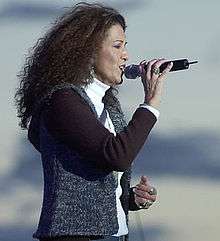
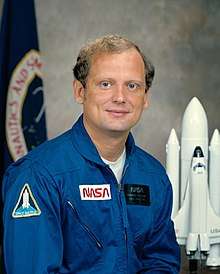
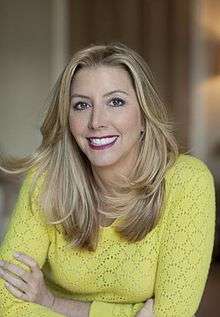 Sara Blakely, founder of Spanx
Sara Blakely, founder of Spanx
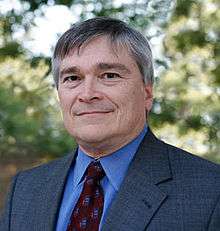
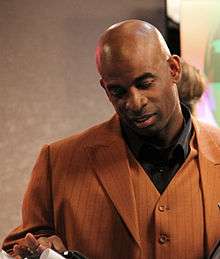


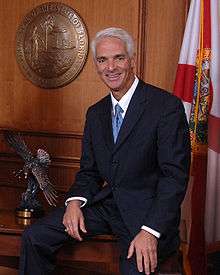
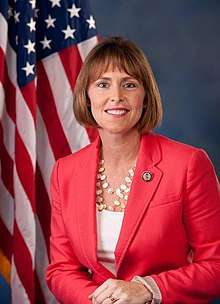
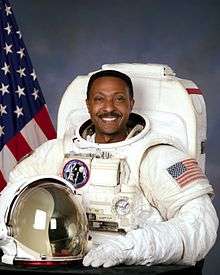 Winston Scott
Winston Scott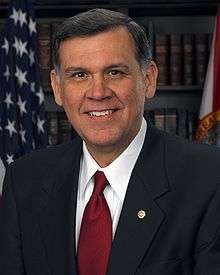 Sen. Mel Martinez
Sen. Mel Martinez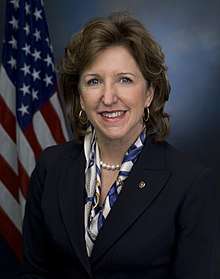

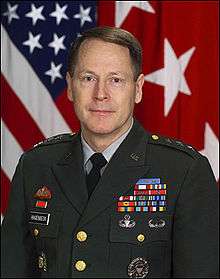
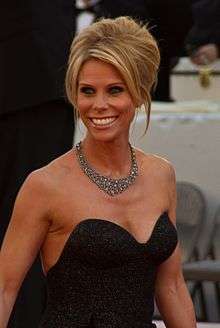

.jpg)
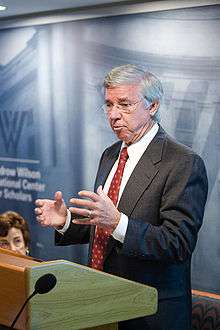



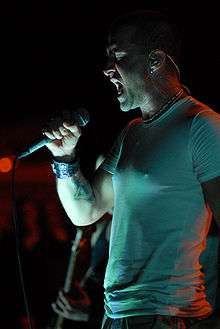
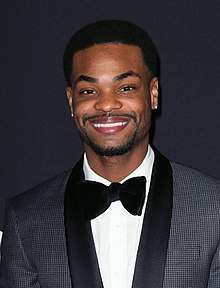 Andrew B. Bachelor, King Bach
Andrew B. Bachelor, King Bach

See also
- Burning Spear Society
- Florida State University School
- Florida State University Police Department
- List of colleges and universities in Florida
- Marching Chiefs
- Master Craftsman Studio
- National Center for Choreography
- The War Chant
Notes
- Florida State University fixes its date of establishment to 1851, the year the Florida legislature voted to establish two seminaries of learning: West Florida Seminary (which became the Florida State University) and East Florida Seminary (which became the University of Florida).[1] West Florida Seminary used this date of establishment prior to 1905, when the Buckman Act reorganized higher education in Florida and the three resulting state institutions all adopted 1905 as their founding date.[2] In 1935 the Florida Board of Control changed the founding dates of the University of Florida[3] and the Florida State College for Women (now Florida State University) to the years their predecessor Seminaries opened as state-sponsored institutions, and Florida State's founding date was changed to 1857. In 2000 the Florida State University declared 1851 to be its official founding date.[4]
References
- "Timeline". The Florida Memory Project. State Library and Archives of Florida. 1851. Archived from the original on August 1, 2010. Retrieved July 9, 2010.
- Meginniss, Benjamin A.; Winthrop, Francis B.; Ames, Henrietta O.; Belcher, Burton E.; Paret, Blanche; Holliday, Roderick M.; Crawford, William B.; Belcher, Irving J. (1902). "The Argo of the Florida State College". The Franklin Printing & Publishing Co., Atlanta. Archived from the original on January 18, 2016. Retrieved April 26, 2013.
- Kirkland, Gary (January 18, 2003). "Happy birthday, UF...but let's get real". Gainesville Sun. Retrieved November 7, 2014.
- Klein, Barry (July 29, 2000). "FSU's age change: history or one-upmanship?". St. Petersburg Times.
- As of June 30, 2019. "U.S. and Canadian 2019 NTSE Participating Institutions Listed by Fiscal Year 2019 Endowment Market Value, and Percentage Change in Market Value from FY18 to FY19 (Revised)". National Association of College and University Business Officers and TIAA. Retrieved April 18, 2020.
- "Regular Faculty". Faculty: Headcount. Florida State University – Office of Institutional Research. 2016. Archived from the original on March 10, 2017. Retrieved May 13, 2017.
- "Office of Institutional Research - Florida State University". www.ir.fsu.edu. Archived from the original on July 19, 2019. Retrieved May 16, 2019.
- "Interactive Enrollment Model". Florida State University – Office of Institutional Research. Archived from the original on June 19, 2019. Retrieved December 17, 2019.
- "Fall 2016 Fact Sheet – Campus Size". Office of Institutional Research. Florida State University. 2014. Archived from the original on March 4, 2016. Retrieved January 21, 2017.
- University Communications. "Colors". Archived from the original on November 16, 2016. Retrieved November 24, 2016.
- "Florida State University". Classifications. The Carnegie Foundation for the Advancement of Teaching. 2018. Archived from the original on June 29, 2018. Retrieved June 29, 2018.
- "Colleges, Schools, Departments, Institutes, and Administrative Units". FSU Departments. Florida State University. April 26, 2013. Archived from the original on April 30, 2013. Retrieved April 26, 2013.
- "Thrasher points to FSU's economic impact". Archived from the original on September 6, 2017. Retrieved August 23, 2016.
- "Florida State University Board of Trustees Meeting". Archived from the original on October 13, 2015. Retrieved May 4, 2016.
- "The John & Mable Ringling Museum of Art". FSU Departments. The John & Mable Ringling Museum of Art. April 26, 2013. Archived from the original on May 17, 2013. Retrieved April 26, 2013.
- "Rankings". www.usnews.com. Archived from the original on September 10, 2018. Retrieved May 16, 2019.
- Joanos, Jim (June 2012). "FSU Athletics Timeline". Archived from the original on July 3, 2013. Retrieved April 26, 2013.
- "Serial Set 4478 57th Congress, 2d session House Document 15, Part 2 map 14". 1820. p. 377. Archived from the original on December 13, 2013. Retrieved December 13, 2013.
- Memorial of the Trustees of the University of Florida (R.K. Call, John G. Gamble, Thomas Randall, Louis M. Goldsborough, Thos. Eston Randolph, F. Eppes, E. Loockerman, Benjamin Chaires, Turbutt R. Betton, Fitch W. Taylor, J. Loring Woart, Ashbeel Steele, J. Edwin Stewart), p. cxxiii. United States Congress. December 7, 1835. Retrieved January 13, 2020.
- "State Library and Archives of Florida – The Florida Memory Project, Florida Constitution of 1838, Article X – Education". Archived from the original on June 24, 2007. Retrieved May 28, 2007.
- "About Florida State – History". Office of University Communications. September 23, 2009. Archived from the original on January 7, 2018. Retrieved January 8, 2018.
- "Book Review: Gone with the Hickory Stick: School Days in Marion County 1845-1960, p.122, The Florida Historical Quarterly - Volume LV, Number 3 January 1977" (PDF). Retrieved July 12, 2010.
- Hare, Julianne (May 1, 2002). Tallahassee - A Capital City History, p.42, Julianne Hare, Arcadia Publishing (May 1, 2002). ISBN 978-0-7385-2371-2. Retrieved July 7, 2009.
- Coles, David J. (1999). Florida's Seed Corn: The History of the West Florida Seminary During the Civil War. Florida Historical Quarterly 77. p. 288. JSTOR 30147582.
- "State Library and Archives of Florida, The Florida Memory Project – Timeline". 1865. Archived from the original on June 7, 2009. Retrieved August 26, 2009.
- "West Florida Seminary cadets taking a break."
"State Library and Archives of Florida – Florida Photographic Collection, West Florida Seminary Cadets, published circa 187-". Archived from the original on September 27, 2009. Retrieved April 29, 2007. - Pugnale, John D. "Family history – Valentine Mason Johnson". Archived from the original on March 3, 2016. Retrieved August 28, 2009.
- Dodd, William G. (1952). History of West Florida Seminary. Tallahassee, Florida: Florida State University. pp. 27–28.
- "FSU 150th Anniversary – History || In the Beginning || The Civil War". Fsu.edu. January 15, 1996. Archived from the original on April 24, 2001. Retrieved December 18, 2012.
- Bush, George Gary (1889). History of Education in Florida. Washington: Government Printing Office. pp. 46–47. Archived from the original on July 25, 2011. Retrieved July 13, 2010.
- Constitutional Convention, Florida (June 9, 1885). Journal of the Proceedings of the Constitutional Convention of the State of Florida, p. 21. Harvard College Library. Retrieved July 13, 2010.
- Armstrong, Orland Kay (1928). "The Life and Work of Dr. A. A. Murphree, p. 40". Retrieved July 13, 2010.
- "State Library and Archives of Florida – Florida Photographic Collection, Westcott Building at the Florida State College for Women, published 193-". Archived from the original on September 27, 2009. Retrieved April 28, 2007.
- "Lewis et al v. Gaillard et al; 61 Fla. 819, 56 So. 281, 12 June 1911". Archived from the original on April 12, 2019. Retrieved September 9, 2013.
- Amy McDonald. (2004). "Florida State University Libraries Special Collections Department, Inventory of the Florida State College for Women Surveys and Reports (MSS2003003), Biographical/Historical Notes" (PDF). Florida State University Libraries. Archived from the original (PDF) on June 14, 2007. Retrieved April 30, 2007.
- VanClay, Erin (September 2005). "Florida State University Libraries Special Collections Department, Inventory of the Florida State College for Women/Florida State University Phi Beta Kappa Alpha of Florida Chapter. (MSS2005-014) Biographical/Historical Notes" (PDF). Florida State University Libraries. Archived from the original (PDF) on September 3, 2006. Retrieved April 30, 2007.
- "Florida Board of Governors SUS Headcount Enrollment – 1905 – present". Archived from the original on October 30, 2010. Retrieved May 18, 2009.
- "Personal history of Mary Lou Norwood, FSCW/FSU Alumna, (transitional) Class of 1947 (FSU webpage)". Archived from the original on September 27, 2016. Retrieved April 30, 2007.
- "2009–2010 General Bulletin". Bulletin. Florida State University – University Registrar. 2009–2010. Archived from the original on November 28, 2009. Retrieved August 29, 2009.
- "Florida State University, News Archive, Events'". Archived from the original on March 3, 2016. Retrieved April 30, 2007.
- "Streaking an FSU First". Florida State Times. April–May 1997. Archived from the original on February 27, 2007. Retrieved June 29, 2007.
- "Streaking". Tallahassee Naturally, Inc. Archived from the original on May 28, 2017. Retrieved June 29, 2007.
- "FSU Black Alumni Association pays tribute to first black student". January 30, 2004. Archived from the original on October 26, 2006. Retrieved April 20, 2008.
- "Walk With Me – Sports Illustrated". November 16, 2005. Retrieved April 20, 2008.
- "More blacks succeed at FSU – St. Petersburg Times November 19, 2007". Archived from the original on February 25, 2008. Retrieved April 20, 2008.
- "FSU Timeline – Exploring FSU's Past". March 4, 1969. Archived from the original on February 20, 2017. Retrieved August 26, 2009.
- "Night of the Long Knives". St. Petersburg Times. March 6, 1969. Archived from the original on August 27, 2009. Retrieved August 26, 2009.
- "Universities Close; Kirk Sits All Night on Campus". The Evening Independent. May 8, 1970. Archived from the original on August 27, 2009. Retrieved August 26, 2009.
- Peralta-Armstrong, Jazmin (February 6, 2010). "Note on LGBSU Founding Date". Tallahassee.com. Archived from the original on February 1, 2013. Retrieved October 11, 2011.
- Eberhardt, Celeste. "Florida State U. LGBT union now the Pride Student Union". University Wire. Retrieved October 11, 2011.
- Koslow, Jennifer. "FSU Timeline". Florida State University. Archived from the original on February 20, 2017. Retrieved October 11, 2011.
- "FSU 'Princess Wouldn't Want a Repeat". Deseret News. Archived from the original on January 20, 2012. Retrieved October 11, 2011.
- Hintikka, M. B. "Severance: Billie Dahhling: Homecoming Princess". Gregory Severance. Archived from the original on January 19, 2012. Retrieved October 11, 2011.
- "News Clips of the State University System of Florida February 18, 2008" (PDF). Board of Governors. Archived from the original (PDF) on November 26, 2011. Retrieved October 11, 2011.
- Baylor, Greg. "FSU Reinstates CLS Chapter Funding". The Center for Law and Religious Freedom. Archived from the original on January 21, 2012. Retrieved October 11, 2011.
- Coalition for an Equitable Community. "Coation for an Equitable Community on Wayback Machine". Wayback Machine. Archived from the original on April 9, 2011. Retrieved October 11, 2011.
- "Gays and lesbians seek protection at FSU" (PDF). Tallahassee Democrat via Board of Governors. Archived from the original (PDF) on November 26, 2011. Retrieved October 11, 2011.
- Hillert, C.J. "Coalition for an Equitable Community v. Union Board" (PDF). Archived (PDF) from the original on April 25, 2012. Retrieved October 11, 2011.
- Pinto, Jessica. "Working Towards Policy Change at FSU". FSView via Young People For. Archived from the original on February 13, 2012. Retrieved October 11, 2011.
- Rodriguez, Rebecca. "Board approves non-discriminatory policy change". fsunews. Archived from the original on December 10, 2014. Retrieved October 11, 2011.
- Image: Hank Hoffman/Illustrations by Christoph Hitz. "Protests That Make the Grade". Mother Jones. Archived from the original on May 16, 2015. Retrieved August 26, 2014.
- Chapter C2000-303, Laws of Florida
- Divya Kumar, "Governor signs bill to grant UF, FSU preeminence Archived October 5, 2015, at the Wayback Machine", The Oracle (April 23, 2013). Retrieved May 25, 2015.
- Lynn Hatter, "FSU, UF Become Florida's 'Preeminent' Universities Archived October 16, 2015, at the Wayback Machine", WFSU (June 10, 3013). Retrieved May 26, 2015.
- Florida State University News. "- Florida State 24/7". Archived from the original on October 5, 2015. Retrieved May 4, 2016.
- "12 Fun Facts about FSU – Tallahassee Democrat". Archived from the original on July 16, 2011. Retrieved September 7, 2008.
- UrbanTallahassee. "FSU Ruby Diamond Expansion". FSU Ruby Diamond Expansion. Urban Tallahassee. Archived from the original on November 29, 2011. Retrieved November 9, 2011.
- "AIA Florida Top 100 Buildings". aiaflatop100.org. Archived from the original on April 29, 2012. Retrieved April 26, 2012.
- "Hours". About the Libraries. Florida State University – Libraries. 2007. Archived from the original on April 13, 2008. Retrieved August 31, 2009.
- "Florida State University Panama City Campus – About FSU Panama City". Archived from the original on September 2, 2006. Retrieved December 28, 2007.
- "FSU Trustees Procedures". Archived from the original on June 22, 2007. Retrieved July 6, 2007.
- "Sally McRorie named provost at FSU". Tallahassee Democrat. November 24, 2015. Archived from the original on November 17, 2018. Retrieved May 4, 2016.
- "FSU Undergraduate Bulletin". fsu.edu. Archived from the original on January 11, 2007. Retrieved March 5, 2007.
- "Headcount Summaries by School/College, Fall Semesters" (PDF). Archived (PDF) from the original on August 9, 2007. Retrieved July 6, 2007. Florida State University – Office of Institutional Research
- "About the College". Florida State University College of Medicine. Archived from the original on April 22, 2007. Retrieved May 11, 2007.
- "Florida State University Foundation 2017-18 Report on Giving" (PDF). Florida State University Foundation. Archived (PDF) from the original on December 20, 2019. Retrieved December 20, 2019.
- "Seminole Boosters – Mission – Florida State University". fsu.edu. Archived from the original on February 15, 2015. Retrieved February 15, 2015.
- "Seminole Boosters – History – Florida State University". fsu.edu. Archived from the original on February 15, 2015. Retrieved February 15, 2015.
- {{|0=September 6, 2015 }}
- Student Government. "Student Government Association". Archived from the original on May 30, 2015. Retrieved May 29, 2015.
- Student Government. "Legislative Branch". Archived from the original on May 30, 2015. Retrieved May 29, 2015.
- Student Government. "Student Government Association". Archived from the original on May 30, 2015. Retrieved May 29, 2015.
- "Strategic Plan_05-13 – Florida State University, p.17" (PDF). The Florida Board of Governors. June 9, 2005. Archived from the original (PDF) on June 13, 2010. Retrieved August 26, 2009.
- Ed-thelen.org Archived April 5, 2007, at the Wayback Machine Jeff Bauer – A History of Supercomputing at Florida State University, 1991 Retrieved on April 30, 2007.
- "Fact book" (PDF). www.ir.fsu.edu. 2018. Archived (PDF) from the original on December 7, 2018. Retrieved May 16, 2019.
- "FSU 2006–2007 General Bulletin Undergraduate Edition – Limited Access Programs". Archived from the original on June 8, 2007. Retrieved April 30, 2007.
- "Tuition & Fees | Student Business Services". studentbusiness.fsu.edu. Archived from the original on January 21, 2019. Retrieved January 20, 2019.
- "Fall 2018 and Spring 2019 | Office of Financial Aid". financialaid.fsu.edu. Archived from the original on January 21, 2019. Retrieved January 20, 2019.
- "Law Cost 2018/2019 | Office of Financial Aid". financialaid.fsu.edu. Archived from the original on January 21, 2019. Retrieved January 20, 2019.
- "Medical 2018/2019 | Office of Financial Aid". financialaid.fsu.edu. Archived from the original on January 21, 2019. Retrieved January 20, 2019.
- "Fact Book" (PDF). www.ir.fsu.edu. 2019. Retrieved April 28, 2020.
- "Fact Sheet". www.ir.fsu.edu. 2020. Retrieved April 28, 2020.
- "Gaduate Admissions Funnel". www.ir.fsu.edu. 2020. Retrieved April 28, 2020.
- "Office of Institutional Research, Common Data Set 2017-18, Item B22". Office of Institutional Research, Common Data Set 2017-18. Archived from the original on August 16, 2018. Retrieved August 15, 2018.
- "Florida State University Rankings". Archived from the original on August 18, 2019. Retrieved August 28, 2019.
- "Fast Facts - Graduation Rates". Institute of Education Sciences, Fast Facts; derived from U.S. Department of Education, National Center for Education Statistics, (2017). The Condition of Education 2017 (NCES 2017-144), Undergraduate Retention and Graduation Rates. Institute of Education Sciences. Archived from the original on May 8, 2016. Retrieved August 15, 2018.
- "U.S. Census Bureau QuickFacts: Florida". www.census.gov. Archived from the original on January 16, 2019. Retrieved November 27, 2018.
- "U.S. Census Bureau QuickFacts: UNITED STATES". www.census.gov. Archived from the original on May 16, 2019. Retrieved May 16, 2019.
- "Fact book" (PDF). www.ir.fsu.edu. 2018. Archived (PDF) from the original on November 16, 2018. Retrieved May 16, 2019.
- "Fact book" (PDF). www.ir.fsu.edu. 2016. Archived (PDF) from the original on November 16, 2016. Retrieved May 16, 2019.
- "Academic Ranking of World Universities 2020: National/Regional Rank". Shanghai Ranking Consultancy. Retrieved August 15, 2020.
- "America's Top Colleges 2019". Forbes. Retrieved August 15, 2019.
- "U.S. College Rankings 2020". Wall Street Journal/Times Higher Education. Retrieved September 26, 2019.
- "Best Colleges 2020: National University Rankings". U.S. News & World Report. Retrieved September 8, 2019.
- "2019 National University Rankings". Washington Monthly. Retrieved August 20, 2019.
- "Academic Ranking of World Universities 2020". Shanghai Ranking Consultancy. 2020. Retrieved August 15, 2020.
- "QS World University Rankings® 2021". Quacquarelli Symonds Limited. 2020. Retrieved June 10, 2020.
- "World University Rankings 2020". THE Education Ltd. Retrieved September 14, 2019.
- "Best Global Universities Rankings: 2020". U.S. News & World Report LP. Retrieved October 22, 2019.
- "Florida State University - U.S. News Best Grad School Rankings". U.S. News & World Report. Retrieved April 27, 2020.
- "Rankings". www.usnews.com. Archived from the original on December 2, 2018. Retrieved September 9, 2019.s
- "Florida State continues meteoric rise in national rankings". September 10, 2018. Archived from the original on September 10, 2018. Retrieved September 10, 2018.
- "nsf.gov - Table 9 - NCSES Survey of Earned Doctorates: FY 2016 - US National Science Foundation (NSF)". www.nsf.gov. Archived from the original on October 4, 2018. Retrieved November 29, 2018.
- "Home – FSU College of Medicine". fsu.edu. Archived from the original on October 17, 2015. Retrieved May 7, 2015.
- "Which Highly Ranked Universities Operate Most Efficiently?". U.S. News and World Report. Archived from the original on December 7, 2012. Retrieved December 7, 2012.
- "Social Mobility Index". Social Mobility Index. CollegeNet and PayScale. 2014. Archived from the original on May 24, 2015. Retrieved June 5, 2015.
- "FSU, UF Become Florida's 'Preeminent' Universities". WFSU.org. Archived from the original on December 27, 2019. Retrieved December 27, 2019.
- "State Fact Sheet - NSF & Florida" (PDF). National Science Foundation. Archived (PDF) from the original on December 27, 2019. Retrieved December 27, 2019.
- "FSU Undergraduate Bulletin". Archived from the original on May 2, 2015. Retrieved May 29, 2015.
- Honors Program. "Honors in the Major". Archived from the original on May 28, 2015. Retrieved May 29, 2015.
- Presidential Scholars Program. "Scholarship Benefits". Archived from the original on May 27, 2015. Retrieved May 29, 2015.
- "FSU's study-abroad programs continue to rise in international education rankings". November 14, 2018. Archived from the original on November 16, 2018. Retrieved November 16, 2018.
- Florida State University International Programs. "International Programs – Home". Archived from the original on April 20, 2016. Retrieved May 4, 2016.
- Florida State University International Programs. "International Programs / FSU – International Programs". Archived from the original on April 20, 2016. Retrieved May 4, 2016.
- "Top University In USA | Best Universities In USA | University In The USA". Uniintheusa.com. Archived from the original on December 23, 2014. Retrieved August 26, 2014.
- Florida State University, The Career Center, FSU. "The Career Center". Archived from the original on May 30, 2015. Retrieved May 29, 2015.CS1 maint: multiple names: authors list (link)
- Florida State University, The Career Center, FSU. "ProfessioNole". Archived from the original on May 21, 2015. Retrieved May 29, 2015.CS1 maint: multiple names: authors list (link)
- Florida State University, The Career Center, FSU. "SeminoleLink". Archived from the original on May 21, 2015. Retrieved May 29, 2015.CS1 maint: multiple names: authors list (link)
- "About CARE - Center for Academic Retention & Enhancement". care.fsu.edu. Archived from the original on November 16, 2018. Retrieved November 16, 2018.
- "CARE students take bridge to a bright future". June 30, 2017. Archived from the original on November 16, 2018. Retrieved November 16, 2018.
- "College Programs - Center for Academic Retention & Enhancement". care.fsu.edu. Archived from the original on November 16, 2018. Retrieved November 16, 2018.
- "University Libraries" (PDF). FSU. Archived (PDF) from the original on January 21, 2019.
- "All FSU Libraries". About the Libraries. Florida State University. 2007. Archived from the original on April 23, 2009. Retrieved August 31, 2009.
- "Strozier Library Starbucks". Starbucks. Campus Dish. Archived from the original on June 1, 2012. Retrieved August 16, 2012.
- "All Libraries". About the FSU Libraries. Florida State University. Archived from the original on October 6, 2012. Retrieved September 8, 2012.
- "Dirac Science library". fsu.edu. Archived from the original on February 15, 2015. Retrieved February 15, 2015.
- "The Paul A. M. Dirac Science Library". The Paul A. M. Dirac Science Library. Florida State University. Archived from the original on May 2, 2011. Retrieved October 11, 2011.
- "Paul Adrien Maurice Dirac Collection". The FSU Library. Florida State University Libraries. Archived from the original on April 29, 2012. Retrieved August 16, 2012.
- "The Claude Pepper Library and Museum". About Us. College of Social Sciences & Public Policy. Archived from the original on July 23, 2012. Retrieved August 16, 2012.
- "About Our Staff". About Us. College of Social Sciences & Public Policy. Archived from the original on July 23, 2012. Retrieved August 16, 2012.
- "The Claude Pepper Center". Home. College of Social Sciences & Public Policy. Archived from the original on July 23, 2012. Retrieved August 16, 2012.
- "Warren D. Allen Music Library". Mission and History. Archived from the original on August 5, 2012. Retrieved February 15, 2015.
- "Collections". fsu.edu. Archived from the original on February 15, 2015.
- "Harold Goldstein Library". Florida State University – College of Communication & Information. Archived from the original on February 15, 2015. Retrieved February 15, 2015.
- Jones, Faye. "FSU College of Law – Research Center". Director's Welcome. Florida State University. Archived from the original on January 10, 2012. Retrieved October 11, 2011.
- "Title XLVIII, 1004.45(2)(a) 2006 Florida Statutes". Archived from the original on February 18, 2010. Retrieved May 2, 2007.
- "Peter Paul Rubens, Paintings in Museums and Public Art Galleries". ArtCyclopedia.com. Archived from the original on October 1, 2009. Retrieved May 2, 2007.
- "John and Mable Ringling Museum of Art". Archived from the original on April 21, 2007. Retrieved May 2, 2007.
- "WINNERS: Best Florida Attraction – Chosen by readers of USA TODAY and 10Best". Archived from the original on January 29, 2014. Retrieved January 25, 2014.
- "A vision rebuilt". sptimes.com. Archived from the original on September 24, 2015. Retrieved May 15, 2015.
- "Museum of Fine Arts at Florida State University". Archived from the original on December 10, 2006. Retrieved May 26, 2007.
- Rashotte, Michael E. (April 5, 2003). "Psychology at Florida State College & Florida State College for Women: 1902–1947". Celebration of 100 Years of Psychology on Campus. Florida State University Psychology Department. Archived from the original (Departmental Website) on February 18, 2010. Retrieved August 31, 2009.
- "Undergraduate Research and Creative Endeavors". Office of Undergraduate Research. Florida State University – Division of Undergraduate Studies. 2009. Archived from the original on August 22, 2009. Retrieved August 31, 2009.
- "FSU Research". Academics and Research. Florida State University – The Graduate School. 2009. Archived from the original on August 1, 2012. Retrieved August 31, 2009.
- "Postdoctoral". Information. Florida State University – The Graduate School. 2009. Archived from the original on August 5, 2012. Retrieved August 31, 2009.
- "nsf.gov - Table 21 - NCSES Higher Education Research and Development short form: Fiscal Year 2016 - US National Science Foundation (NSF)". ncsesdata.nsf.gov. Archived from the original on November 13, 2018. Retrieved November 13, 2018.
- "Fact book" (PDF). www.ir.fsu.edu. 2015. Archived (PDF) from the original on September 24, 2015. Retrieved May 16, 2019.
- "Interdisciplinary Graduate Degree Programs". The Graduate School. Florida State University. 2009. Archived from the original on May 29, 2015. Retrieved May 28, 2015.
- "National High Magnetic Field Laboratory – Media Center Fact Sheets – Records". Archived from the original on February 27, 2015. Retrieved May 28, 2015.
- "NSF denies MIT appeal". The Tech (Online Edition). Archived from the original on November 26, 2011. Retrieved August 26, 2009.
- "FSU gets National Magnet Lab". The Tech (Online Edition). Archived from the original on November 26, 2011. Retrieved August 26, 2009.
- "FSU physicists helping make history at new Large Hadron Collider". Archived from the original on September 10, 2008. Retrieved September 10, 2008.
- "The CMS Experiment at CERN". Archived from the original on July 20, 2008. Retrieved September 10, 2008.
- Florida State University, HPMI, High Performance Materials Institute, FSU. "HPMI Overview". Archived from the original on May 29, 2015. Retrieved May 29, 2015.CS1 maint: multiple names: authors list (link)
- "Center for Advanced Power Systems (CAPS)". Archived from the original on May 29, 2015. Retrieved May 29, 2015.
- Florida State University News. "World's most powerful electrical testing system unveiled". Archived from the original on May 29, 2015. Retrieved May 29, 2015.
- "Coastal & marine Laboratory About Us". Archived from the original on November 3, 2011. Retrieved September 25, 2011.
- "Coastal & marine Laboratory History". Archived from the original on July 13, 2011.
- "FSU Office of Institutional Research – Frequently Asked Questions". Archived from the original on July 19, 2012. Retrieved December 28, 2007.
- "State Library and Archives of Florida – Florida Photographic Collection, West Florida Seminary Football Team at College Hall, published 1899". Archived from the original on June 14, 2007. Retrieved April 29, 2007.
- "The Argo of the Seminary West of the Suwanee, Tallahassee, Fla. (circa 1900), page 28 (image 33)". Archived from the original on September 4, 2006. Retrieved May 8, 2007.
- "The Hymn to the Garnet and Gold: A Tradition in the Making". TallahasseeScene. Archived from the original on October 17, 2015. Retrieved May 29, 2015.
- "Florida State University Board of Trustees Meeting". fsu.edu. Archived from the original on February 26, 2015. Retrieved January 26, 2015.
- "Florida State University – Office of Greek Life". Archived from the original on April 25, 2007. Retrieved May 5, 2007.
- Florida State University Housing. "FSU – University Housing". Archived from the original on June 12, 2015. Retrieved May 29, 2015.
- "FSU Admissions – Student Life". Archived from the original on April 30, 2016. Retrieved May 4, 2016.
- Chalmers, Erik (September 6, 1991). "New FSU student rec center scheduled to open Monday". Florida Flambeau (Vol. 77, No. 10). Archived from the original on February 12, 2017. Retrieved May 25, 2016.
- "Fitness Facilities – Florida State University Campus Recreation". fsu.edu. Archived from the original on February 8, 2015. Retrieved December 7, 2018.
- "Florida State University, Campus Recreation – Sport Clubs". Archived from the original on May 14, 2007. Retrieved May 8, 2007.
- "Intramural Sports – Florida State University Campus Recreation". fsu.edu. Archived from the original on February 13, 2015. Retrieved January 27, 2015.
- "FSU Campus Recreation – Rec SportsPlex". Archived from the original on May 26, 2010. Retrieved August 26, 2009.
- "Oglesby Union – Crenshaw Lanes". Archived from the original on August 25, 2009. Retrieved August 26, 2009.
- "Club Downunder". Archived from the original on January 29, 2009. Retrieved August 26, 2009.
- "Askew Student Life Center". Archived from the original on December 12, 2012. Retrieved August 26, 2009.
- "Student Life Building CyberCafé website". Archived from the original on June 8, 2007. Retrieved December 28, 2007.
- "FSU Reservation". Archived from the original on August 28, 2009. Retrieved August 26, 2009.
- "FSU Reservation – History". Archived from the original on January 21, 2012. Retrieved August 26, 2009.
- "FSU Flying High Circus". Archived from the original on February 26, 2011. Retrieved August 26, 2009.
- "History of the FSU Flying High Circus". Archived from the original on May 4, 2009. Retrieved April 15, 2009.
- https://www.usnews.com/best-colleges/florida-state-university-1489/student-life
- "Office of Greek Life". Homepage. Florida State University. 2015. Archived from the original on May 2, 2015. Retrieved May 28, 2015.
- "Multicultural Greek Council". Office of Greek Life. Florida State University. 2015. Archived from the original on December 18, 2007. Retrieved May 28, 2015.
- Matt Haag, Florida State Halts Fraternity Activities After Student’s Death Archived November 8, 2017, at the Wayback Machine, New York Times (November 7, 2017).
- Pledge Death, Greek Life Suspension to Dampen FSU Homecoming Archived November 8, 2017, at the Wayback Machine, Associated Press (November 7, 2017).
- "FSU Interfraternity Council – Fraternities". Archived from the original on September 25, 2009. Retrieved August 27, 2009.
- "FSU Panhellenic Association". Archived from the original on December 18, 2007. Retrieved August 27, 2009.
- "Natural Bridge – Wakulla County, Florida". Archived from the original on October 13, 2007. Retrieved April 11, 2009.
- "Harpe-Johnson Building (ROTC)" (Graphic). FSU Campus Map. Florida State University. 2009. Archived from the original on October 17, 2015. Retrieved January 15, 2015.
- "Reserve Officers' Training Corps". FSU ROTC Homepage. Florida State University. 2009. Archived from the original on November 25, 2001. Retrieved August 31, 2009.
- "Seminole Express Bus Service". Archived from the original on May 30, 2015. Retrieved May 29, 2015.
- "Other Services". Archived from the original on May 30, 2015. Retrieved May 29, 2015.
- "Tallahassee Regional Airport – Airport". Archived from the original on May 22, 2015. Retrieved May 29, 2015.
- "Corporate media on campus? Florida State University paper sold to Gannett Co". The Brown Daily Herald. September 19, 2006. Archived from the original on September 29, 2007. Retrieved July 6, 2007.
- "Florida State University – Television Stations WFSU and WFSG". Archived from the original on June 1, 2007. Retrieved May 28, 2007.
- "Florida State University – Radio Stations WFSU-FM, WFSQ-FM and WFSW-FM". Archived from the original on April 15, 2007. Retrieved May 28, 2007.
- "Florida State University – Radio Station WVFS-FM". Archived from the original on June 6, 2007. Retrieved May 28, 2007.
- "Masthead". The Southeast Review. Archived from the original on September 17, 2013. Retrieved August 18, 2013.
- "Florida State University thanks Seminoles for historic vote of support" (Press release). Florida State University – FSU News. June 17, 2005. Archived from the original on February 18, 2010. Retrieved September 1, 2009.
- Wieberg, Steve (August 23, 2005). "NCAA allowing Florida State to use its Seminole mascot". USA TODAY. Archived from the original on October 19, 2015. Retrieved October 14, 2015.
- "Rivals". Archived from the original on March 20, 2016. Retrieved May 4, 2016.
- "Inside College Sports: SEC, Big Ten dominate $100M revenue club". CBSSports.com. Archived from the original on May 4, 2016. Retrieved May 4, 2016.
- McGahee III, Wayne (August 2, 2020). "Financial pain". Florida Today. Melbourne, Florida. pp. 1B. Retrieved August 9, 2020.
- "Track & field team honored at White House". FSU News. June 19, 2007. Archived from the original on May 2, 2008. Retrieved December 31, 2007.
- "Veterans of Modern Warfare Kansas Chapter KCK # 10 (website)". Archived from the original on December 4, 2008. Retrieved December 31, 2007.
- "Seminoles.Com (Official Athletic Site of Florida State University) – Scott Speicher Tennis Center". Archived from the original on December 29, 2007. Retrieved December 31, 2007.
- "Florida Soccer Drops 1–0 Decision at No. 2 FSU in Front of Record Crowd". soccerFLA.com. September 8, 2006. Archived from the original on December 16, 2006. Retrieved January 1, 2008.
- "Seminoles.Com (Official Athletic Site of Florida State University) – JoAnne Graff". Archived from the original on December 8, 2007. Retrieved September 24, 2007.
- "NCAA Legislative Services Database - Category: Major Infractions". Archived from the original on October 8, 2018. Retrieved December 22, 2017.
- "This is FSU Baseball 2007 – Great Moments in FSU Baseball". Archived from the original on January 20, 2013. Retrieved January 1, 2008.
- "Bobby Bowden Field at Doak S. Campbell Stadium". Florida State Seminoles. June 23, 2017. Archived from the original on April 1, 2019. Retrieved May 16, 2019.
- "FSU Football – Pre 1947 teams". Archived from the original on June 12, 2011. Retrieved April 23, 2011.
- "Profile: Bobby Bowden". Seminoles.com. Archived from the original on July 3, 2007. Retrieved June 30, 2007.
- "3peatTrojans's SportingBlog: The Great College Football Debates: Coaches pt.3". SportingNews.com. Archived from the original on October 2, 2007. Retrieved July 6, 2007.
- "Paterno loses 111 wins in NCAA sanctions, Bowden becomes new wins leader". Archived from the original on April 7, 2013. Retrieved July 23, 2012.
- "theACC.com – The Official Website of the ACC – 2006–07 ACC Championships Sites and Dates". Archived from the original on October 12, 2007. Retrieved January 1, 2008.
- "theACC.com – The Official Website of the ACC – 2005–06 ACC Championships Sites and Dates". Archived from the original on October 12, 2007. Retrieved January 1, 2008.
- "theACC.com – The Official Website of the ACC – 2004–05 ACC Championship Track & Field". Archived from the original on October 20, 2007. Retrieved January 1, 2008.
- "Florida State University, Student Profiles – Garrett Johnson". Archived from the original on February 22, 2007. Retrieved May 8, 2007.
- "Track & Field: FSU Wins Back-to-Back National Titles". Seminoles.com. Archived from the original on November 13, 2007. Retrieved June 9, 2007.
- "Office of Institutional Research - Florida State University". www.ir.fsu.edu. Archived from the original on January 7, 2019. Retrieved May 16, 2019.
- "About FSU's Faculty". Archived from the original on February 7, 2017. Retrieved May 4, 2016.
- "Faculty Honors and Awards". Archived from the original on December 10, 2012. Retrieved July 1, 2007.
- Bauer, Jeff (1991). "A History of Supercomputing at Florida State University". Archived from the original on April 5, 2007. Retrieved April 30, 2007.
- "Hypolithic Algae at Johnson Canyon-Death Valley Sample Collection of March 5–7, 1997". Archived from the original on September 26, 2007. Retrieved July 10, 2007.
- "E. Imre Friedmann, Robert O. Lawton Distinguished Professor and Director, Polar Desert Research Center". Archived from the original on June 14, 2007. Retrieved July 10, 2007.
- Gulf Coast Museum, Mysterious Clarity: Mark Messersmith, Ray Burggraf, Lillian Garcia-Roig: May 17 – July 27, 2008, Accessed March 2013, <http://www.gulfcoastmuseum.org/EXHIBITIONS/exhibitions07_08.html Archived May 5, 2015, at the Wayback Machine>
- Kang, J., 2010 Dissertation, Florida State University, "How Four North Florida Artists Address Environmental Issues In Their Art with Implications for Art Education" <http://etd.lib.fsu.edu/theses/available/etd-12172009-072548/unrestricted/Kang_J_Dissertation_2010s.pdf%5B%5D>
- 621 Gallery, Archive, 2004, A Mysterious Clarity <http://www.621gallery.org/exhibitionsevents/archive/2004.html Archived July 3, 2013, at the Wayback Machine> Accessed March 2013.
- "Florida State University, Alumni Association – About Us" (PDF). Archived (PDF) from the original on September 28, 2018. Retrieved September 28, 2018.
- "Home - The Rhodes Scholarships" (PDF). www.rhodesscholar.org.
- "Winning Institutions Search". Office of the American Secretary – The Rhodes Trust. 1905. Archived from the original on May 23, 2013. Retrieved April 26, 2013.
- "Gerald Ensley: FSU lays claim to the state's first Rhodes scholar". November 20, 2012. Archived from the original on October 30, 2014. Retrieved April 26, 2013.
- "Florida's First Female Rhodes Scholar". The Dispatch, Lexington, N.C. December 13, 1976. Retrieved April 26, 2013.
- "Student body president becomes second FSU Rhodes Scholar in three years". Retrieved November 7, 2007.
- "FSU student-athlete Garrett Johnson wins Rhodes Scholarship". Archived from the original on December 11, 2005. Retrieved July 21, 2005.
- "FSU's Myron Rolle named 2009 Rhodes Scholar". Archived from the original on January 16, 2009. Retrieved November 22, 2008.
- "B. Dan Berger Senior Vice President of Government Affairs – Biography". National Association of Federal Credit Unions. Archived from the original on September 28, 2007. Retrieved January 14, 2008.
- "Professor Dan Berger gets rated by students". TheHill.com. Archived from the original on December 19, 2007. Retrieved January 14, 2008.
- Bidney, Beverly (December 31, 2014). "Louise Gopher bestowed with FSU honorary degree" (PDF). Seminole Tribune. Archived from the original (PDF) on March 17, 2015. Retrieved May 23, 2016.
- "Florida State University, Seminoles.Com website for FSU Athletics – FSU Hall of Fame". Archived from the original on April 19, 2009. Retrieved July 1, 2007.
- "Noles In The Pros". Florida State Seminoles. July 5, 2017. Archived from the original on April 1, 2019. Retrieved May 16, 2019.
Sources
- Adams, Alfred Hugh (1962). A History of Public Higher Education in Florida, 1821‑1961. Florida State University.
- Bush, George G. (1889). History of Education in Florida. Washington, D.C.: U.S. Bureau of Education, Circular of Information 1888, # 7.
- Campbell, Doak Sheridan (1964). A University in Transition: Florida State College for Women and Florida State University, 1941‑1957. Florida State University.
- Dodd, William George (1948). "Early Education in Tallahassee and the West Florida Seminary, Now Florida State University". Florida Historical Quarterly (XXVII): 1‑27.
- Dodd, William George (1952). History of West Florida Seminary. Florida State University. B0007E7WRS.
- Dodd, William George (1952). West Florida Seminary, 1857‑1901; Florida State College, 1901‑1905. Tallahassee: none.
- Dodd, William George (1958–1959). Florida State College for Women, Notes on the Formative Years (1905‑1920)‑‑With a Postscript: The Twenties; and Epilogue: The Forties 1940‑1944. Tallahassee: none.
- Eisenberg, Daniel (1986). "In Tallahassee" (PDF). Journal of Hispanic Philology. 10 (2). pp. 97–101.
- Marshall, J.Stanley (2006). The Tumultuous Sixties – Campus Unrest and Student Life at a Southern University. Tallahassee: Sentry Press. ISBN 1-889574-25-2.
- McGrotha, Bill (1987). Seminoles! The First Forty Years. Tallahassee Democrat. ISBN 0-9613040-1-4.
- Rhodes, Barbara (1994). At First – The Presbyterian Church in Tallahassee, Florida, 1828–1938. First Presbyterian Church, Tallahassee, Florida.
- Sellers, Robin Jeanne (1995). Femina perfecta: The genesis of Florida State University. FSU Foundation. ISBN 0-9648374-1-2.
External links
| Wikimedia Commons has media related to Florida State University. |
| Wikiquote has quotations related to: Florida State University |
